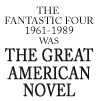







 |
 |
 |
 |
 |
 |
 |
 |
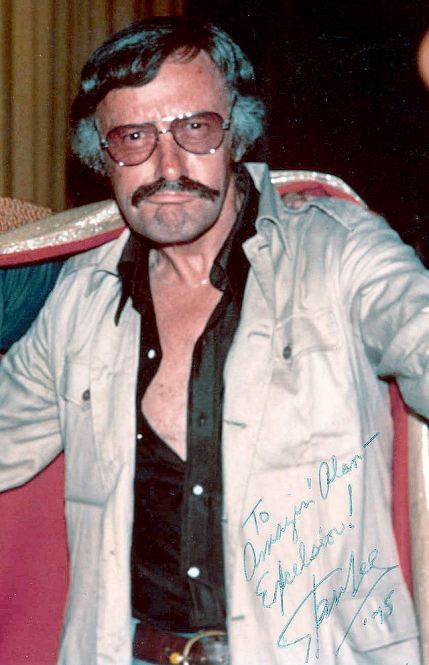
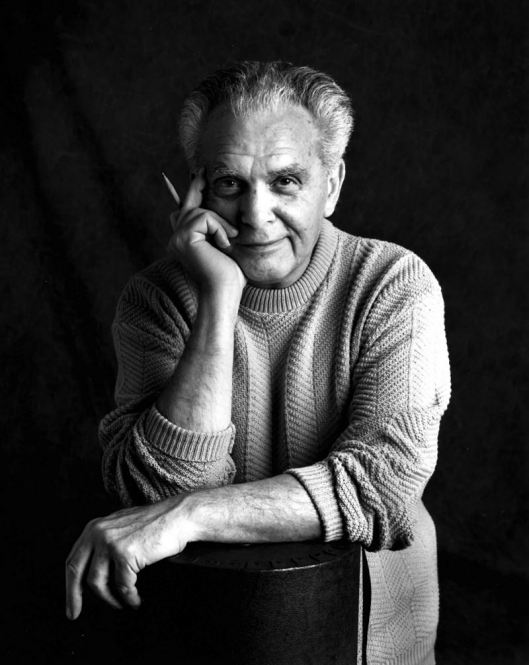
Answer: they each created the whole thing. On their own. It
depends on how you define the question.
Stan Lee created Marvel Comics, with a big M and big C: the corporation as we know it. Jack Kirby created Marvel comics with a small c: the individual stories.
Stan Lee was just as creative as Kirby, but in a different way. This is what Stan Lee created:
Stan's position is not in doubt. He deserves his millions of dollars,
his fame and his endless fans. Stan does not need defending: his
achievements speak for themselves. I want to start with that., and drive
home the point with a sledge hammer., Because otherwise what follows
might get ugly. I am going to argue that Jack Kirby wrote the actual
comics, and Stan simply dumbed them down to reach a wider audience.
Them's fighting words! But read the evidence and judge for yourself.
Both before and after the early 1960s, Stan Lee was not known for producing great new ideas. Jack Kirby, on the other hand, was always producing big ideas, such as Captain America (co-created with Joe Simon) and the Fourth World series for DC (entirely on his own, immediately after leaving Marvel).
Stan Lee was just too busy to write everything, and would
often just deliver the faintest outline for a script. In this
letter from 1965 (printed in the book "The Stan Lee Universe")
he outlines what became known as "the Marvel method:
Stan would often would just phone in a suggestion and Jack
would do the rest, delivering the pages for dialog to be
added. For example, Stan said something like "this month have
the Fantastic Four fight God" and Jack then created the
Galactus saga, perhaps the greatest comic story ever.
Famously, when Stan first saw the Silver Surfer he asked
"who's this guy?"
"Very often," Lee has said,
"I didn't know what
the hell [Kirby] was going to give me. I’d get some pages of
artwork, and I wrote the copy and turned it into whatever
story I wanted it to be ... It was like doing a crossword
puzzle. I would try to figure out what the illustrations
meant and then I would put in the dialog and captions.” (Source)
Kirby would even add blue pencil notes for dialog. Stan would
then add the actual dialog (which often contradicted what Jack
wanted, but Jack seldom had time to read the finished comic).
In 1968, the magazine "Castle of Frankenstein" #12 published a Stan Lee interview where he said “Some artists, such as Jack Kirby, need no plot at all. I mean I’ll just say to Jack, ‘Let’s let the next villain be Dr. Doom’… or I may not even say that. He may tell me. And then he goes home and does it. He’s so good at plots, I’m sure he’s a thousand times better than I. He just about makes up the plots for these stories. All I do is a little editing… I may tell him that he’s gone too far in one direction or another. Of course, occasionally I’ll give him a plot, but we’re practically both the writers on the things.” (emphasis added) In interviews such as that it seems that when Stan says "writing" he means adding the dialog to the finished art, but when Jack Kirby says "writing" he means deciding what happens from panel to panel, and adding notes in the margins as needed.
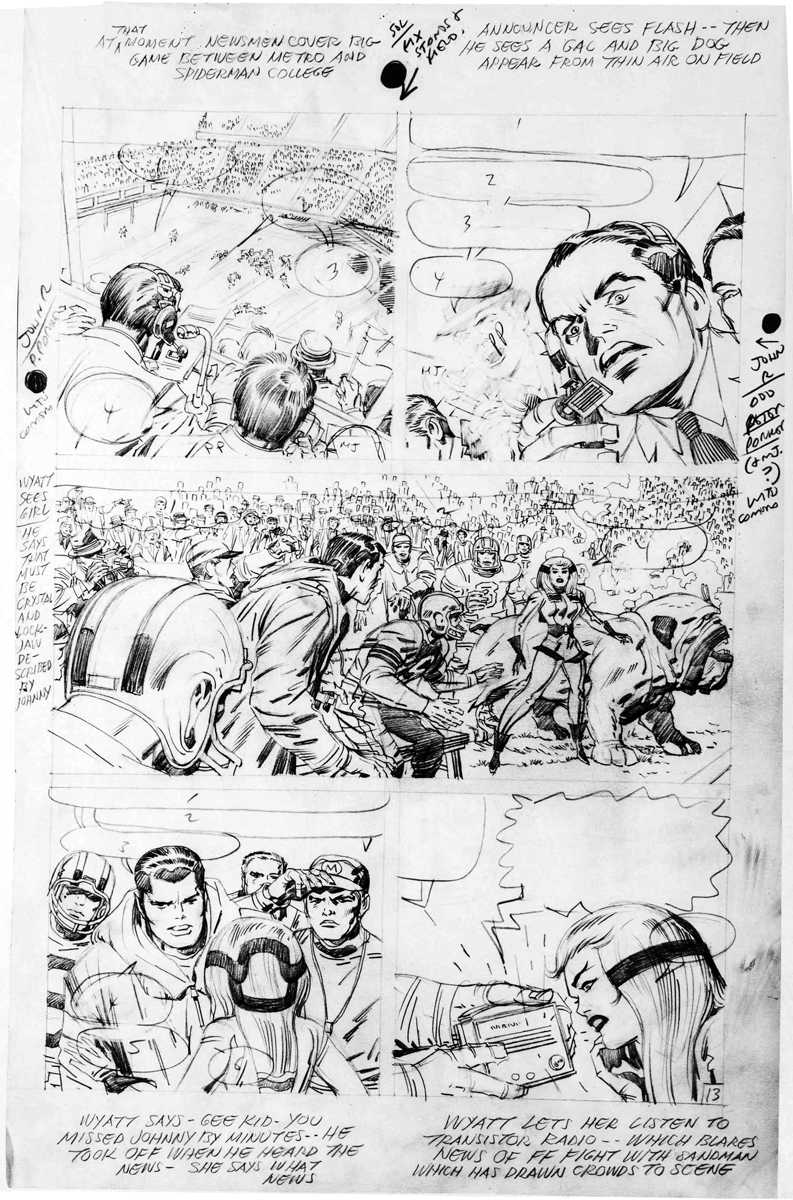
Almost everything in the early FF has similarities with other
Jack Kirby creations. In particular, the FF has many parallels
with Challengers of the Unknown, a series Kirby had just
produced for DC. It was about four friends who survived a
plane crash and dedicated their lives to the good of mankind.
Even the suits were the same. Issue 2 featured one of them
crashing in a space ship and gaining various super powers. For
full details see Dial B For
Blog, probably the greatest comic blog ever.
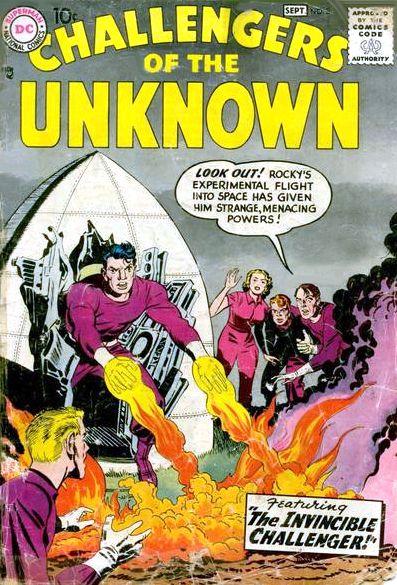
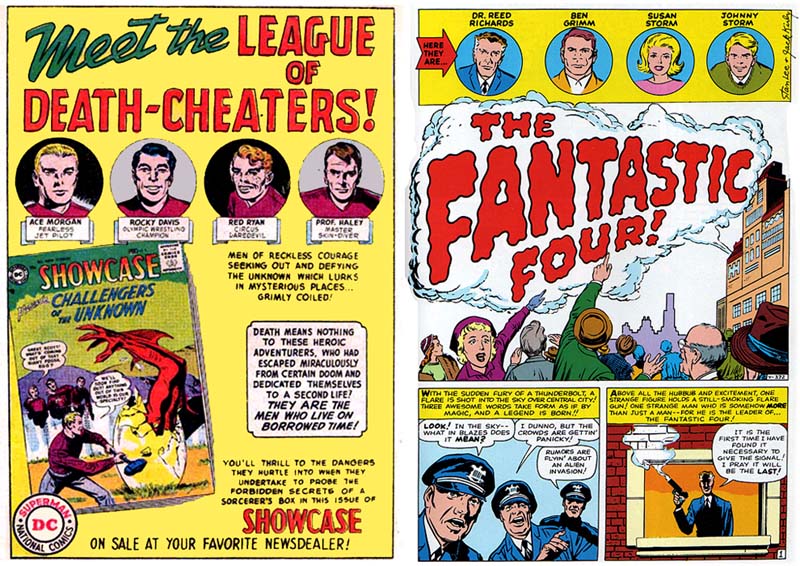
In later years, Kirby stated plainly that he created it all.
Stan openly admits to having a notoriously bad memory, so how
he remembers it may not be as others remember it.
Stan has a powerful motive for claiming credit: copyright law
means that if Kirby created it then he (or his estate) would
now be due hundreds of millions of dollars in royalties. But
Stan is always the consummate company man, so as long as he
claims credit (and takes his million dollar a year salary)
Marvel is legally safe.
Kirby ignored most of what Stan wrote. This is from John Romita Sr: "I heard them plotting in other instances! [laughter] Jack would say, 'Stanley, I think I’ve got an idea. How ’bout this?' Stan would say, 'That’s not bad, Jack, but I’d rather see it this way.' Jack would absolutely forget what Stan said, and Stan would forget what Jack said. [laughter] I would bet my house that Jack never read the books after Stan wrote them; that’s why he could claim with a straight face that Stan never wrote anything except what Jack put in the notes. He was kidding himself; he never read them.
Jack Kirby was only paid as an artist, but he felt he should be
paid more because he also contributed story ideas. He believed he
had been promised payment and it never came, so he finally left
Marvel. Years later, in the 1980s, Jack was fighting to get his
original art back from Marvel, and the two sides became polarized.
Some fans felt that clearly Stan did everything. Others felt that
he had taken credit for Kirby's work. Still others felt that their
contribution was equal. The battle rages to this day. So who is
right?
Some people argue that Jack Kirby created everything. These
quotes were assembled by Patrick Ford
(see the comments section in the link):
Stan Goldberg:
” Stan would drive me home and
we’d plot our stories in the car. I’d say to Stan,”How’s this?
Millie loses her job.” He’d say,”Great! Give me 25 pages.” And
that took him off the hook. One time I was in Stan’s office and
I told him, “I don’t have another plot.” Stan got out of his
chair and walked over to me, looked me in the face, and said
very seriously, “I don’t ever want to hear you say you can’t
think of another plot.” Then he walked back and sat down in his
chair. He didn’t think he needed to tell me anything more.”
[interviewer: ” Sounds
like you were doing most of the writing then.”]
“Well, I was.”One time I
was in Stan’s office and I told him, “I don’t have another
plot.” Stan got out of his chair and walked over to me, looked
me in the face, and said very seriously, “I don’t ever want to
hear you say you can’t think of another plot.” Then he walked
back and sat down in his chair. He didn’t think he needed to
tell me anything more.”
For contrast, Goldberg said this about Kirby:
“Jack would sit there at lunch,
and tell us these great ideas about what he was going to do
next. It was like the ideas were bursting from every pore of his
body. It was very interesting because he was a fountain of
ideas. One day Jack came in and had this 20-page story and
proceeded to tell us he was having his house and studio painted.
I asked, “Where did you draw the story?” Jack said,”I put my
board on the stair banister, and drew it.”
"The fact is we had no story or
idea discussion about Spider-Man books even before issue #26 up
to when I left the book. Stan never knew what was in my plotted
stories until I took in the penciled story, the cover, my script
and Sol Brodsky took the material from me and took it all into
Stan’s office, so I had to leave without seeing or talking to
Stan."
The legendary artist Wally Wood goes even further:
Did I say Stanley had no smarts?
Well, he DID come up with two sure fire ideas… the first one was
“Why not let the artists WRITE the stories as well as draw
them?”… And the second was … ALWAYS SIGN YOUR NAME ON TOP …BIG”.
And the rest is history … Stanley, of course became rich and
famous … over the bodies of people like Bill [Everett] and Jack
[Kirby]. Bill, who had created the character that had made his
father rich wound up COLORING and doing odd jobs.
Gil Kane's opinion of Stan Lee is apparently similar.
"On each page, from 1964 – 1970 next to every single panel Jack wrote extensive margin notes explaining to Lee what was taking place in the story. It took Jack about 2 weeks do do a single story, it may have taken Lee as little as 4 hours to add text to Jack’s art." (source)
If Stan plucked Jack from obscurity then Jack should be grateful! But Jack Kirby was already famous: far more famous than Stan Lee. "Simon and Kirby" was the most famous double act in comics, probably even beating Siegel and Shuster. The names "Simon and Kirby" even appeared on covers, because their names sold comics.

For my money, Jack Kirby writes the best dialog in the business. But not everyone feels that way.
"Overblown
as Lee's dialogue could be - “Stand back, human! None may leave this
building by imperial order of Prince Namor himself!” - it had a certain
corny charm. Kirby's characters spoke in a stilted, awkward dialect
which was sometimes very hard to read. In that debut issue of his Jimmy
Olsen series, for example, he has Morgan Edge declare: “No deal, no how,
Kent! Not you, Buddy Boy! The 'hairies' who inhabit the wild area -
trust nobody over twenty-five!” (source)
By this definition Shakespeare also writes stilted dialog:
"Friends, Romans, countrymen, lend me your ears; I come to bury Caesar, not to praise him. The evil that men do lives after them; The good is oft interred with their bones"
See how Shakespeare's ideas jump around and use weird language. But maybe that's becaue he's so old? Then how about this:
"O, Great Northern Mall, you dwindling oracle of upstate New York, your colossal lot of frost-heaved spaces so vacant I could cut straight through while blinking and keep my eyes shut,"
The National Poetry society awarded that first prize in 2015.. Poetry is like that. You have to read it slow, savour its words. So let's take another look at Kirby's "stilted dialog" example:
“No deal, no how, Kent!"
How is that hard to understand? Here is conflict, the heart of good
writing! And this is a sentence a real person might say (the speaker is an older New Yorker in 1970)
"Not you, Buddy Boy!"
And now we have personality and teasing. Something that the Stan Lee Namor example lacks. And notice the implication that the speaker and the listener are social equals. This makes the conflict meaningful: the speaker could actually lose. But in the Namor example, the power is so one sided that there is no tension.
"The 'hairies' who inhabit the wild area"
A short sentence fragment, but packed with poetic imagery and useful information. "Haries" brings with it Hippie connotations, with political and social meaning. It also tells us that the older group look down on the younger, finding them crude and uncivilized. And yet they have hair, they are full of youth and vigour.
"- trust nobody over twenty-five!”
This is the key dialog. This is what I wanted to get to. It brings us to the next topic, feet of clay:
"One of
Marvel's most striking innovations had been to give its heroes
commonplace problems in their civilian lives, and a degree of ambiguity
about whether their powers were a blessing or a curse. Spider-Man was
always short of money, for example, and The Thing gained his phenomenal
strength only at the cost of his new, hideous appearance." [I have
deleted Stan's quote where he takes credit] "This approach played
a big part in Marvel's early success, Lee's the only common factor in
all the debut books using it, and its not something you find in either
Kirby or Ditko's solo work. For all those reasons, it's fair to credit
Lee as its inventor" (source)
We only have to open any Kirby story at random to refute that. Let's look again at the previous "stilted language" for example:
“No deal, no how, Kent! Not you, Buddy Boy! The 'hairies' who inhabit the wild area - trust nobody over twenty-five!”
Think of what that means. The speaker is older but cannot trust the young. So? Despite being older, larger, more experienced man, and having the authority and power of the state to back him up, he cannot deal with the youth. He has no power, despite his power! This is real weakness, real feet of clay. The guy is weak despite being strong. This is how feet of clay work in the real world.This is true for all Kirby creations: their weaknesses are serious and real. Kirby's Captain America has only the strength of a human athlete, no more. Kirby's Orion must fight against his own father. More importantly, Kirby created more than just superheroes. For example, Kirby and Simon literally invented the whole romance genre. An entire genre based on stories of human weakness.
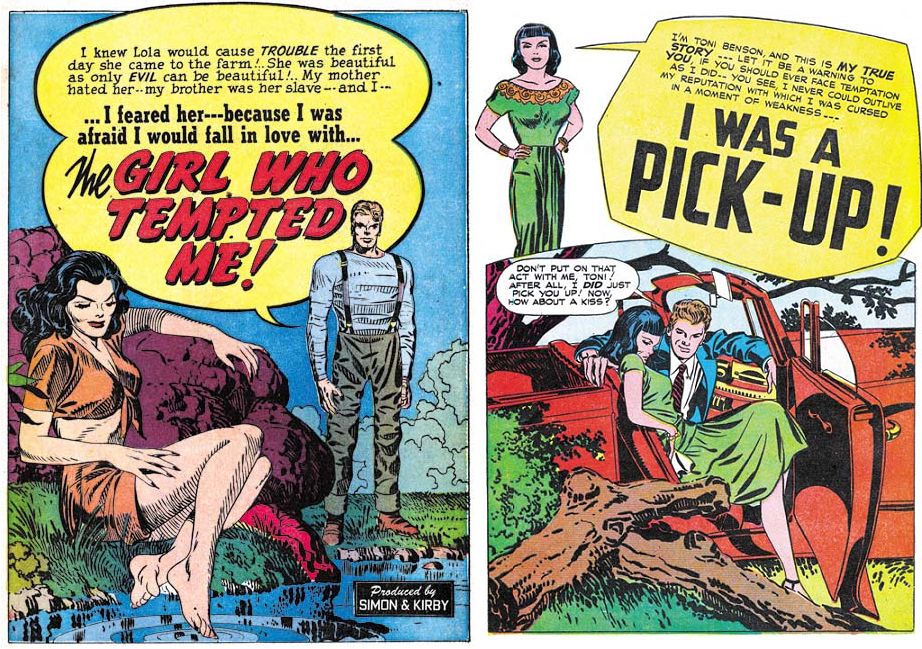
None of Stan Lee's comics were as adult in their themes and approach
as Kirby's adult oriented comics. I don't mean juvenile interests like
sex and violence, I mean real adult themes, like marriage (the romance
comics), psychology (Strange World of Your Dreams), or Kirby's own
direct experience of fighting in World War II. Some of Kirby's earliest
work was adapting classic novels: superhero and monster comics were just
a small part of his repertoire.
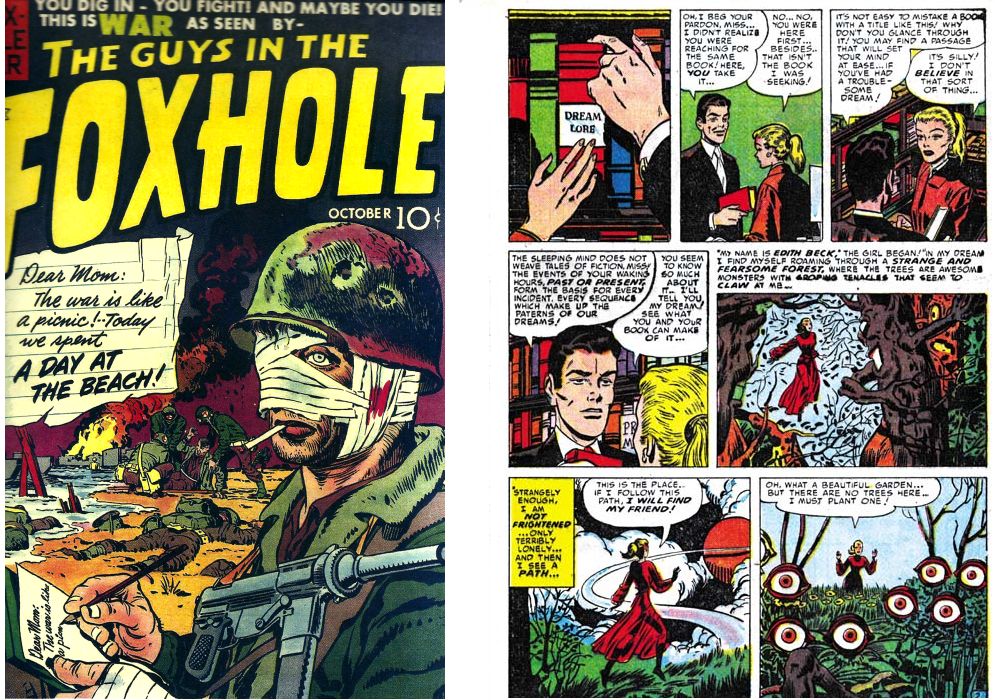
This is hardly surprising, as Kirby had seen the real world. he fought in the war, he set up his own businesses (e.g. with Joe Simon), he worked for different people. He spent most of his time working at home surrounded by books, listening to the news on the radio. He created collages from the science magazines he read. Here for example is Jack at work with Joe Simon: note the books always at hand:
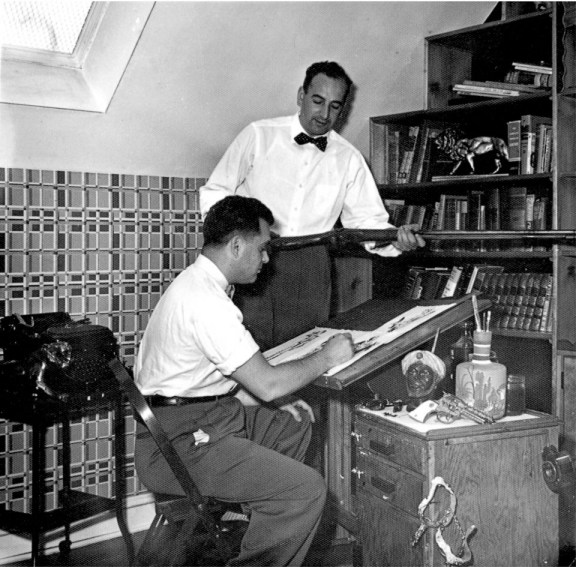
And here he is after he left Marvel, circa 1972. Again notice the books on the shelves.
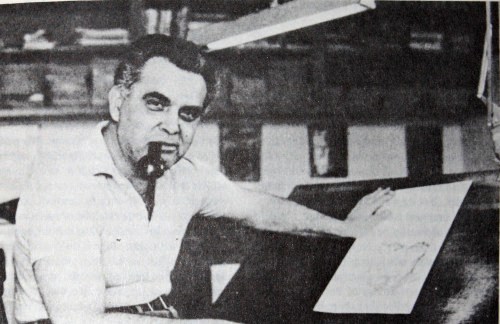
Or listen to his interviews: he is always wondering, always thinking about big questions of life, the universe and everything. This man is a thinker who was always coming up with original concepts.
Kirby, with Joe Simon, created the romance genre. Kirby wrote war stories from experience, where friends lie dead and dying. So Kirby could not communicate emotion? Hmmm.
For an example of intense emotion in Kirbys solo works, see the discussion of Captain Victory.
There are numerous other criticisms, but they are generally opinion, and are based on a particular reading of the facts. For example:
"Jack simply not understanding that
the audience for comics had moved on since the 1940s and 1950s and a
Big Idea was no longer enough" (source)
I have the opposite opinion: I think Kirby was too far ahead of his
time. Kirby's creations now earn billions at the box office, but Kirby
didn't live to see any of that money. And I don't just mean
creations where Stan Lee was also involved. DC movies contain a lot of
Kirby's ideas too, from the time after he left Marvel. At time of
writing (July 2016) it looks like the upcoming Justice League movie will
rely heavily on New Gods ideas (Darkseid, boom tubes, Apoklolips,
etc.). And many commentators have suggested that George Lucas drew on Kirby's ideas for Star Wars. Here I will look at just one example: how George Lucas created Darth Vader.
Kirby's influence on Darth Vader
Star Wars drew on many sources. Old movies are an obvious influence:
Saturday morning Flash Gordon serials, WWII dog fights, etc. But Lucas
openly admits to getting ideas from comics (such as the "Classics
Illustrated" version of "War of the Worlds": see Star Wars Insider 41,
p.26). George Lucas was
reading a lot of comics when he planned Star Wars: he even part owned the "Supersnipe Comic Art Gallery",
part of the famous Supernipe comic shop. Let's look at Darth Vader for
example. Ralph McQuarry's original design was a cross between a Samurai
and a Nazi:
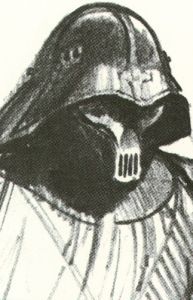
Lucas's final version was changed, and was more like Dr Doom. He had Doom's hideously scarred face, Doom's mix of magic and science, and a father-son story plucked straight from Kirby's Darkseid and Orion. Darkseid of course is pronounced "dark side". The death star is like Apokolips with its fire pits, this Darth Vader scene in Empire is almost identical to an unforgettable FF scene from 1974 (based on an earlier Kirby scene), and so on.
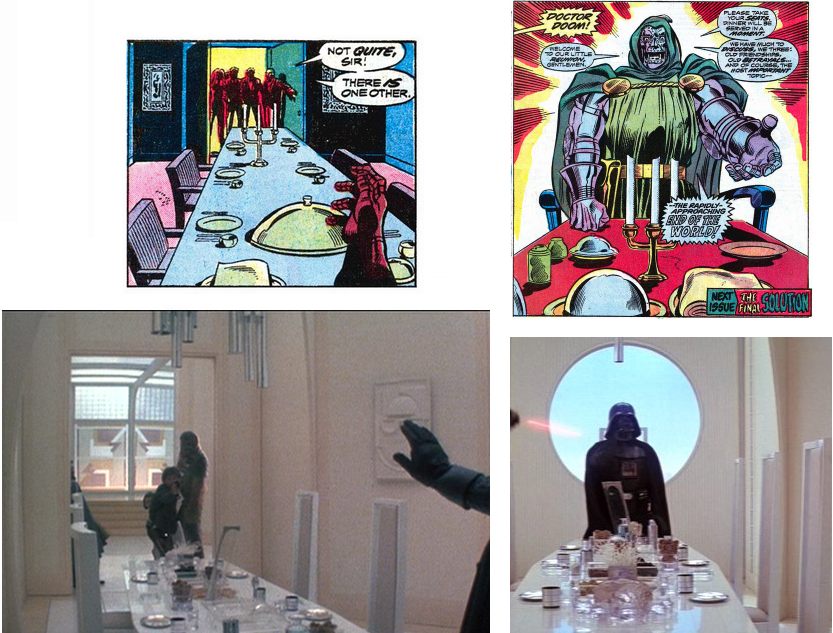
Kirby even had a
character called Skywalker in his "Justice Inc" comic (issue 2).

(By the way, note how Kirby routinely used the name "Avenger" before Stan Lee started using it: Turok was the first "Aveger" back in Simon and Kirby's Captain America 1)
This doesn't prove anything of course. But the similarities were obvious at the time. As Mark Hamill recalled:
MARK: It was at Bill Mumy's house in Laurel Canyon. I also went out to [Jack's] house once in Thousand Oaks. [Jack] was a very self-effacing guy. You'd never know from his demeanor how important he really was. We were joking, and I said that when I first saw Darth Vader, I thought, "Oh, it's Doctor Doom." (laughter) He certainly didn't say, "Oh, he took my ideas," or any of that kind of stuff. He was content with who he was and his abilities." (source)
Given Kirby's fame among comic readers in the early 1970s (when Lucas was planning Star Wars) it is difficult to argue that comic fan Lucas was not aware of Darkseid or Dr Doom. My point is not that Lucas stole from Kirby: all creative people "steal" ideas and develop them further. My point is that Kirby dealt with powerful, eternal concepts, and he did it first. Kirby was not behind the times. He was way out in front.
Stan Lee is superb at self promotion. So his name is strongly linked to the characters he worked on. Take Captain America for example. Captain America was created by Joe Simon and Jack Kirby, yet "Many fans -- and even Lee himself, once -- have erroneously credited Lee with having created the character" (source, emphasis added)
The recent Captain America movie has Stan Lee in the credits, but
there are no references to Simon and Kirby. The movie has a cameo role
for Stan Lee, but not for anyone representing Simon or Kirby. In big
letters the movie calls Cap "The First Avenger", referring to the
characters closely associated with Stan Lee. The movie set features a
shop called "Excelsior Cigars", a reference to Stan's catch phrase. Stan
is often photographed with Captain America imagery, and signing Captain
America comics. And so it goes on.
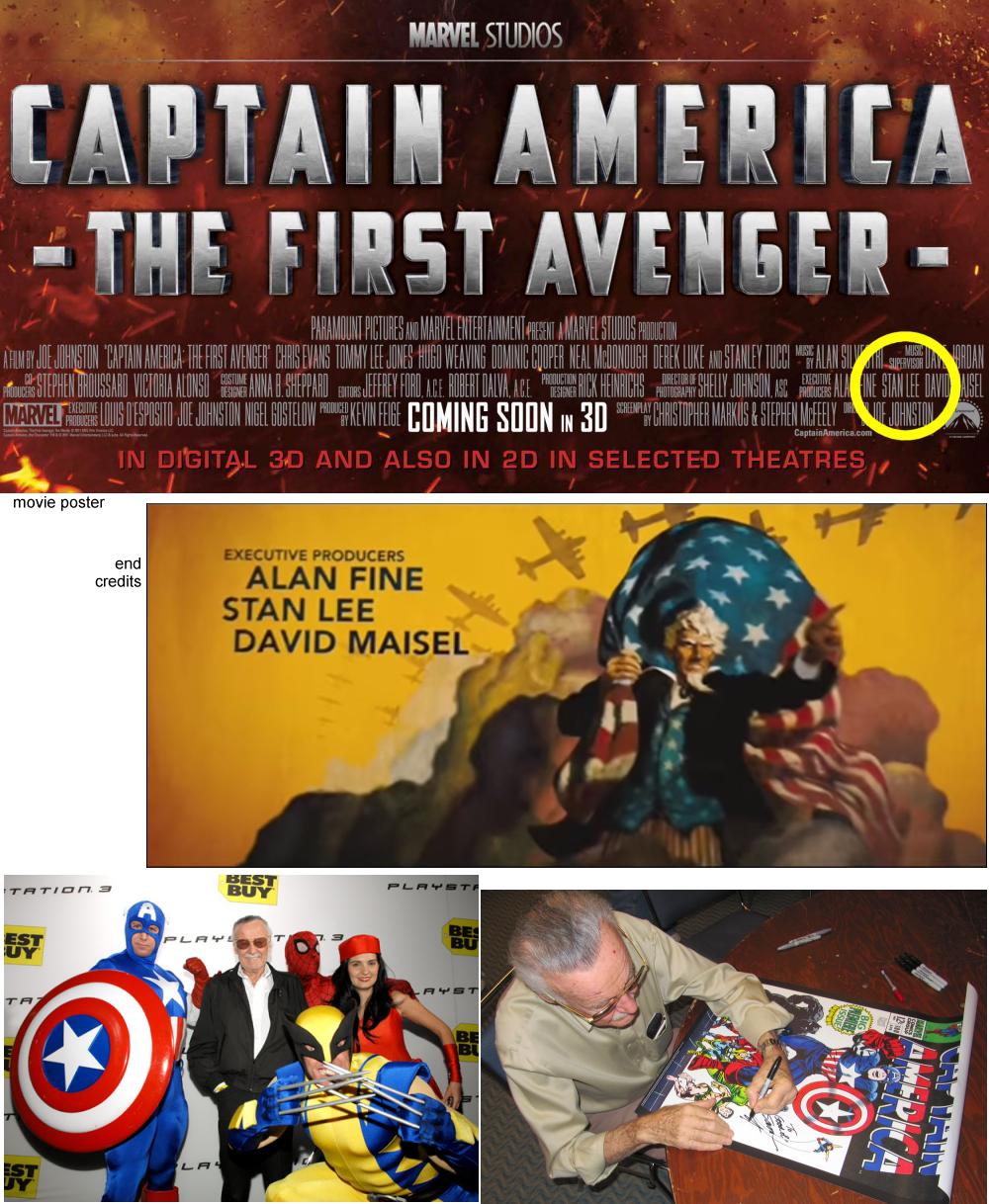
"I have this really bad habit, though I do it out of love and pride for my grandfather. Whenever I see someone wearing a Captain America t-shirt, I like to first compliment them on their stellar choice, and then I ask, “Do you know who created Captain America?” Answers have varied. Some may say they don’t know, few say Simon and Kirby, and many say Stan Lee." - Megan Margulies, granddaughter of Joe Simon. (source)
This is not new. In 1984 the planned Captain America movie advertised Cap as "Stan Lee's Character". (source)
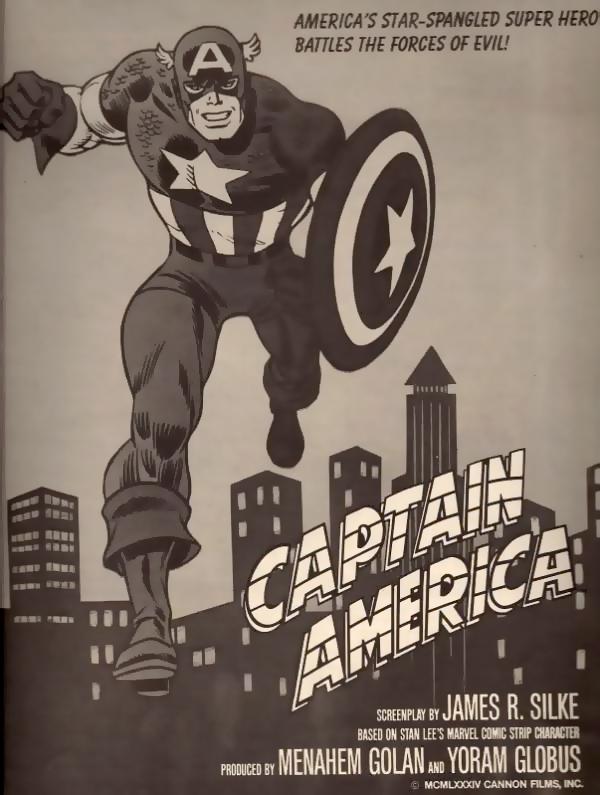
"1985 March 6: A Cannon Films ad in Variety magazine erroneously credits Stan Lee as the creator of Captain America. The Kirbys’ attorney contacts Marvel Comics about the error." (source)
Thirty years later Marvel Studios still linked Stan Lee to the name
Captain America, without mentioning Simon and Kirby. Prominent fans encouraged a movie boycott.
"Jack Kirby's co-creator credit appears nowhere in the promotion of 'The Avengers.' His fans have expressed outrage over the way his contributions to the movie's very existence are being swept under the rug. Stephen Bissette (co-creator of 'Constantine,' and noted 'Swamp Thing' artist) called for a boycott of Marvel comics and merchandise, while James Sturm, co-founder of the Center for Cartoon Studies, also published an essay explaining his decision to boycott the movie." (source)
Marvel was afraid to admit credit because the Kirby family wanted a share of the profits. But with so much money at stake Marvel finally offered the Kirbys an undisclosed sum to resolve the dispute. So from 2015 Kirby's name will sometimes appears alongside Stan Lee's. But Stan Lee's name and likeness are far more prominent in general publicity. Kirby's supporters still have to be on guard for claims like this:
John Arcudi
@ArcudiJohn
"Stan Lee did not co-create "Captain America" as is stated in his
biography on Comic Con International's website. How can we get this
fixed?" (source)
So while Stan does not actively say "I did it" his name is generally the one in the credits. Alan Moore put it bluntly:
"Alan Moore [...] was scathing about Lee, who he accused of falsely claiming responsibility for the creation of Captain America during his panel" (source)
But Stan Lee's dominance of the message is so complete that readers replied that Alan Moore was "full of BS" and "Stan-bashing"
"I don't think I have heard or read anywhere that Stan Lee ever said he created 'Captain America'. [...] I get a bit tired of the Stan-bashing."
"I love Alan Moore's work but dang... He is so full of BS opinions" (source)
Captain America is a clear cut case. Stan had nothing to do with the
character's creation, yet he was the only one credited on screen.
Stan Lee's concept of creation was illustrated (literally!) back in 1947, in his book "Secrets Behind the Comics".
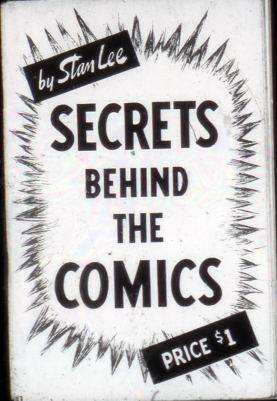
In the book, Stan states that the name on the book is not necessarily the person who actually wrote or drew it:
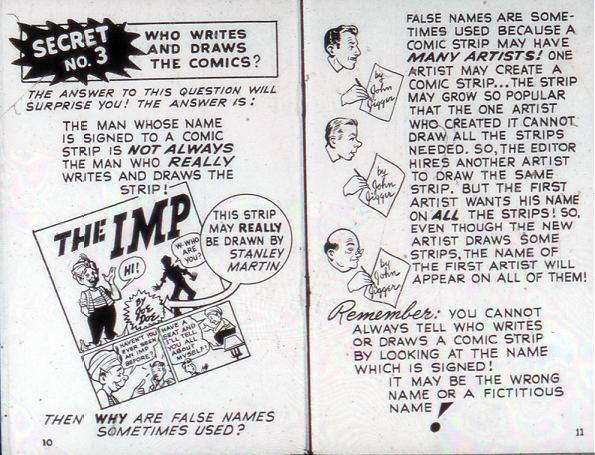
Stan then showed us who he thought was the real creator behind a strip. He used the example of, you guessed it, Captain America.

It is clear that Stan Lee thought that publisher Martin Goodman was the genius, the only name that mattered. Stan did not even mention Joe Simon or Jack Kirby. Yet Simon and Kirby had already created the character before offering it to Goodman. As long time comic reader Kurt F. Mitchell explains:
"According to Joe Simon's 'My Life in Comics,' he and Jack had created the entire first issue of Captain America before Simon was hired to be Timely's first in-house editor. Had he not been hired just then, Cap might well have wound up at Centaur or Novelty Press and became THEIR million-copies-a-month cash cow instead of Goodman's."
There is no reason to doubt either man on this. Simon and Kirby ran their own comic publishing house and routinely produced new characters. They are among the most prolific comic inventors in history. Goodman in contrast was a magazine publisher, who cared little for comics: he was far more interested in the bigger and more lucrative men's magazine section. Goodman was famous for two things: ruthless business practices (which were the norm back then) and copying trends created by other people. To suggest that he worried about the comics or came up with original comic ideas is, shall we say, an interesting slant on history. Reader "Ish Kabbible" suggests why Simon and Kirby were not mentioned by name.
"By this time [1947]. both creators had long left Marvel and in fact might have already been in competition with Marvel as the publishers of Prize Comics. Of course Marvel would not jeopardize their claim over what those two had created for them in the past by giving them credit at this stage of the game. Martin Goodman was well aware of what was going on at that time between DC and Jerry Siegel & Joe Shuster."
Siegel and Shuster are relevant to this story: in 1947 they had just
been fired for trying to get the rights to the character they created.
This was the year when Stan Lee published "Secrets Behind the Comics",
which argues that the publisher of a comic (e.g. Martin Goodman) is the
real creator of the characters. Comics historian Jamie Coville gives the
background. Siegel and Shuster sold Superman to DC when they were both
young. They were then both drafted into the war. When they came back
they found that not only was DC making millions from their creation, but
were also making millions from a derivative character, Superboy,
without paying Siegel or Shuster an extra dime. So in 1946 they hired a lawyer.
"The
two of them would also lose their jobs in 1947 because of this legal
battle. [they finally settled oput of court ion 1948]. The two of them
would briefly give comic strips another try with a Funnyman character.
But it wasn't successful. Afterwards Joe Shuster would quit comics
altogether.
Jerry Siegel and his family
were broke, their economic status had gotten so bad that Siegels wife
Joanne, visited Jack Liebowitz at DC and told them how bad things were.
She asked him 'Do you really want to see in the newspaper-Creator of
Superman Starves to Death?' Jack Liebowitz did not, so DC gave Siegel
some writing assignments in 1958. At a price, Jerry would receive no
credit or special privileges for his work. But sometime in 1964 Jerry
made a comment about wanting to be treated better, and he was
immediately fired for it." (source)
Stan Lee's view of creation was that the publisher hires the writers
and therefore the publisher is the creative force. This seems a long
stretch for Martin Goodman, who thought so little of comics that he
hired his teenage cousin (Stan Lee: writer at 16, editor at 17)
to run the entire line. But perhaps it was more true of Stan himself?
After all, Stan was intimately involved with every stage of production.
This leads us to "The Marvel Method", where an artist would write his
own stories, after a discussion with Stan Lee, and Stan would then shape
the final dialog. Let's look at The Marvel Method in more detail.
The "Marvel Method" was in place long before Fantastic Four issue 1. This is from "Secrets Behind the Comics", where Stan talks about scripts, and also about artists who like to write:
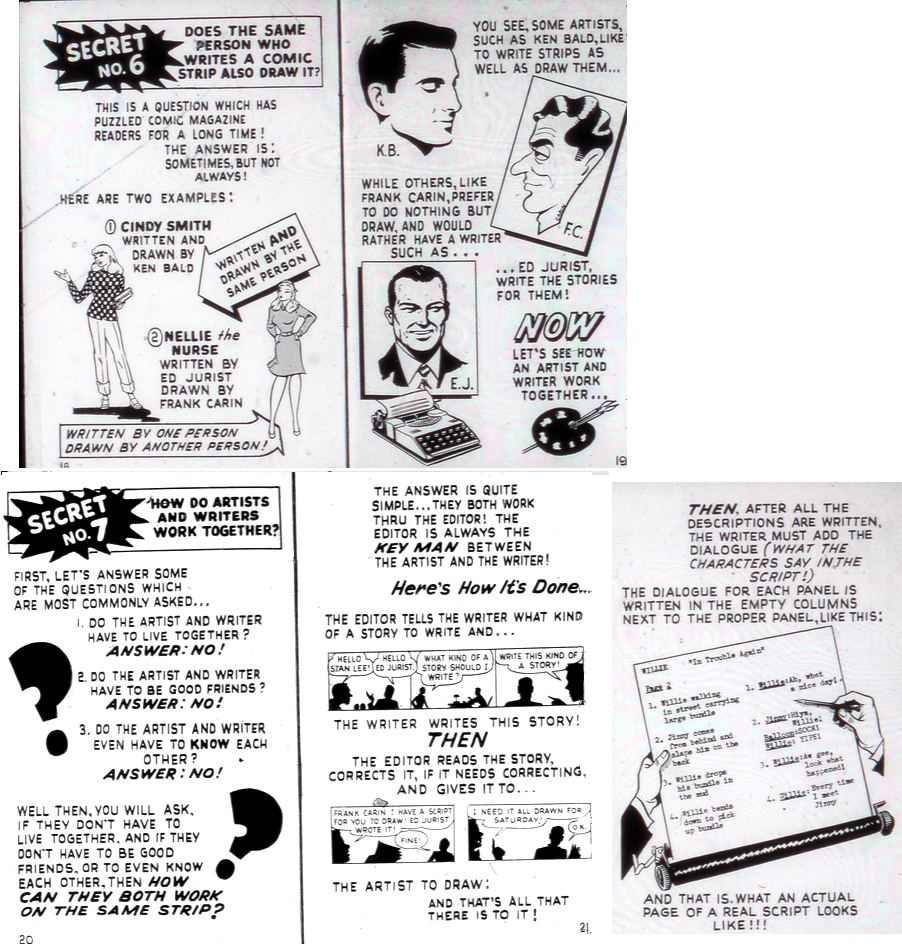
Note the picture of the script: panels on one side, dialog in the margins. Compare this to the pencils of the Fantastic Four, elsewhere on this page. This is exactly what Jack Kirby produced for Stan Lee, except that instead of describing each picture he drew it. He put the dialog is in the margins, and Stan then approved or changed it. Exactly as Stan describes it.
Later we will look at the story conferences, and the document for FF
issue 1 that Stan called a "synopsis". The synopsis refers to the
meeting between the writer and Stan Lee, whereas the script refers to
the frames and dialog, such as Kirby produced. Now let us look at how
Stan described the life of a writer-artist:
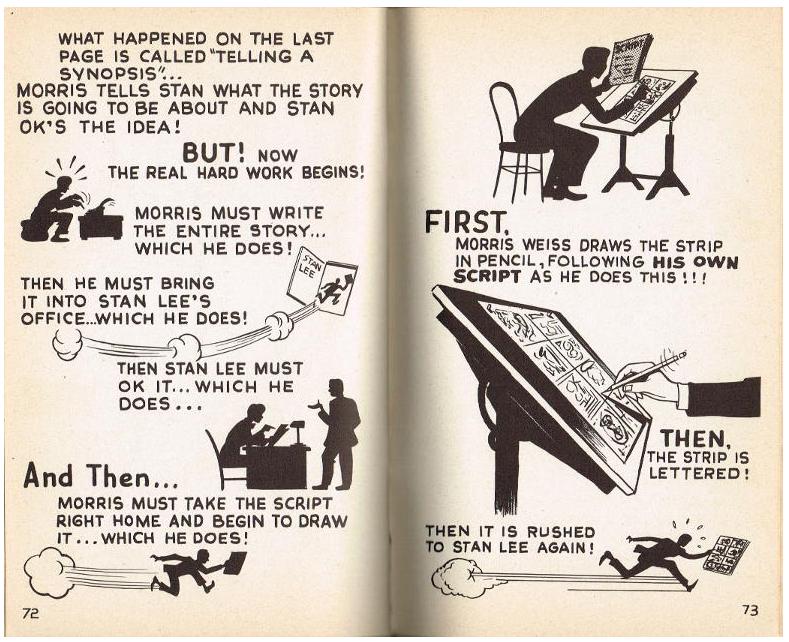
This is exactly how Jack Kirby described the process: Jack had the ideas, then Stan would approve or change them and add his own ideas. But Stan was in overall control. He especially needed to show his control in the case of Jack Kirby, because Kirby had previously created a multi-million dollar idea, then left to work for rivals. Besides, Stan Lee's dislog was more popular with the mostly young comic readers of the time. So when Stan changed Jack's dialog he may have improved the sales.
This is not to say that Stan never wrote scripts. Stan wrote a lot of scripts! A lot of artists didn't want to do plotting, or weren't good at it. At these times Stan wrote a full script, and al the ideas are his. For a comparison of Stan's scripts and Jack's scripts click here.
Stan's book mentioned that a writer-artist always discussed the story synopsis first. What were these meetings like? How detailed was he discussion?
We have seen that later story conferences were often nothing more than Kirby telling Lee what he planned. But everything hinges on the early story conferences. Is that where Stan provided the key ideas? We only have one direct eye witness account of a full story conference (Flo Steinberg reports hearing them in the early days, but they were behind closed doors so we can't know who came up with what) . In late 1965 the reporter Nat Freedland visited the Marvel offices for an article published in the New York Herald Tribune, January 9th 1966. In part of it he reports on a "weekly Friday morning summit meeting with Jack 'King' Kirby". This is what Freedland wrote (as reprinted in the Collected Jack Kirby Collector, Volume 4):
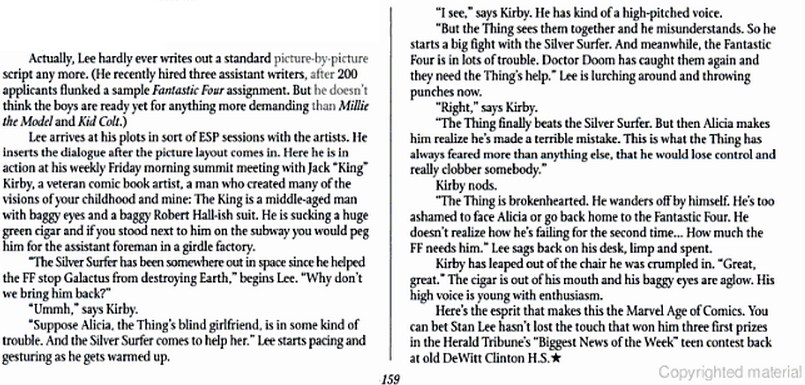
The date and content indicates they are planning FF55. At first this
supports the idea that Stan Lee came up with all the ideas. But look
closer:
From this we learn that:
So this meeting was almost certainly expanded because the journalist
wanted it. After all, if you're planning a major newspaper item
then
you want to report that you have seen the inner workings. So Stan
played the part. However, when this story was published it made Kirby
look weak. Roz
(Jack's wife) was mad. This article was a major contributor to Jack's
disaffection with Marvel. Flo Steinberg has reported that in the early
days Jack used to come in weekly or even more, and their story
conferences could become noisy, with stories acted out. But after this
we were more likely to have Jack's recollection of him just coming to
the office every two weeks or so to drop off his work, and the story
conferences being little more than a brief phone call.
The very first conference
The most important story conference of all is discussed further down
the page: the
conference before issue 1. We will see the same pattern: Stan wrote it,
and Jack ignored most of what Stan said: Jack didn't even see the typed
up notes.
Two thirds of the finished comic was not in the synopsis, much of what Stan did say was ignored, and the parts that did end up in the comic reflected Jack's earlier work. E,g, Jack had created many creature called "The Thing", he was familiar with the earlier Human Torch from his work on Captain America, and so on. In short, nobody is denying that Stan and Jack spoke before each issue, or that Stan could write comics, or that Stan liked to be in control. But Jack did not think much of Stan's ideas and ended up using his own.
John Romita's recollection
John Romita recalls times where Stan and Jack planned a story:
"I was present at at least two plotting sessions of John — Jack and Stan Lee. They were the same as my plotting sessions and the same as Gene Colan’s and Herb Trimpe’s and John Buscema. John Buscema actually did his plotting by phone, because he lived two hours away from the city."
So "plotting session" could sometimes meant just a phone call. This is how it went:
"One guy would make a suggestion, Jack would say, 'that’s not a bad idea, but what if we did it this way,' and then Stan would say, 'okay, but only if we did it that way' and 'only if we did it this way.' They were both talking different plots and it’s -and the reason I know it is because when Stan and I would plot, I foolishly did it from memory. I never recorded it."
So Stan and Jack
were "both talking different plots". Romita gives more detail in another interview
"CBA: In the past, you’ve told that great anecdote about realizing they weren’t listening to the other!
"John: I knew that even when I heard them plotting in other instances! [laughter] Jack would say, “Stanley, I think I’ve got an idea. How ’bout this?” Stan would say, “That’s not bad, Jack, but I’d rather see it this way.” Jack would absolutely forget what Stan said, and Stan would forget what Jack said. [laughter] I would bet my house that Jack never read the books after Stan wrote them; that’s why he could claim with a straight face that Stan never wrote anything except what Jack put in the notes. He was kidding himself; he never read them." (source)
Romita then mentioned Jack's (mainly Roz's) reaction to the Herald-Tribune article:
"CBA: Did you see any of the problems Jack was having?
"John: I had heard all of the inside stuff, like from the Herald-Tribune
article that insulted Jack, that he thought Stan was a part of. Stan
could not convince him of that, and certainly could not convince Roz
that Stan hadn’t encouraged the writer to make fun of Jack. I know for a
fact that Stan would rather bite his tongue than say such a thing,
because Jack’s success would’ve been his success. There’s no reason to
run Jack down. Stan had the position; he didn’t have to fight Jack for
it. I don’t think Jack ever wanted the editorial position; if he wanted
credit, he deserved credit. Stan used to give him credit all the time;
he used to say most of these ideas are more than half Jack’s. Why they
would think Stan would try to make him look bad in print is beyond me;
but from that time on—which is very close to when I started there in the
middle ’60s—when the Herald-Tribune article came out, there were very
strained relations, and I thought it was a matter of time before Jack
would leave..." (source)
Sometimes Stan did not understand Jack's story. This is further evidence that Jack wrote them and Stan simply added dialog. See FF 15 for a good example:
Kirby understood DNA and wrote a story about it. Stan did not, so he
changed the story. For other examples of changed stories see FF 8, FF 23, FF 67, FF 108, etc.
There is no doubt that Stan's changes and his dialog made Jack's work
easier to read. I would never have persevered with Jack Kirby if not
for
Stan's easy dialog. But did Stan improve the stories? Or merely dumb them down?
The golden age of the Fantastic Four is generally agreed to be twenty
issues either side of FF 50. This coincides with the period when Stan
became too busy to do much beyond add the dialog. This golden era ended when Jack
began holding back his best ideas (to become part of the
New Gods). Then when Jack left, the quality dropped again.
In Stan's defence, we do have a record of one change he made that allegedly improved a Kirby story. So let's look at that claim in detail.
T'Challa, the character who we know as the Black Panther was created by Jack Kirby as the "Coal Tiger". He had tiger stripes on his costume and no face mask. Stan told Jack to change the name to "Black Panther", make the costume all black, and add a full face mask. Most fans say this was a great improvement. They say "Coal Tiger" sounds silly and the new costume is cool. This is of course a matter of opinion. But we cannot overlook the serious problems with the changes. For example, while Jack's original design showed T'Challa's face, Stan wanted it covered. So Jack gave T'Challa a half mask. But Stan wanted T'Challa's face completely covered, and a redrawn cover: the new cover pushes T'Challa into the background.
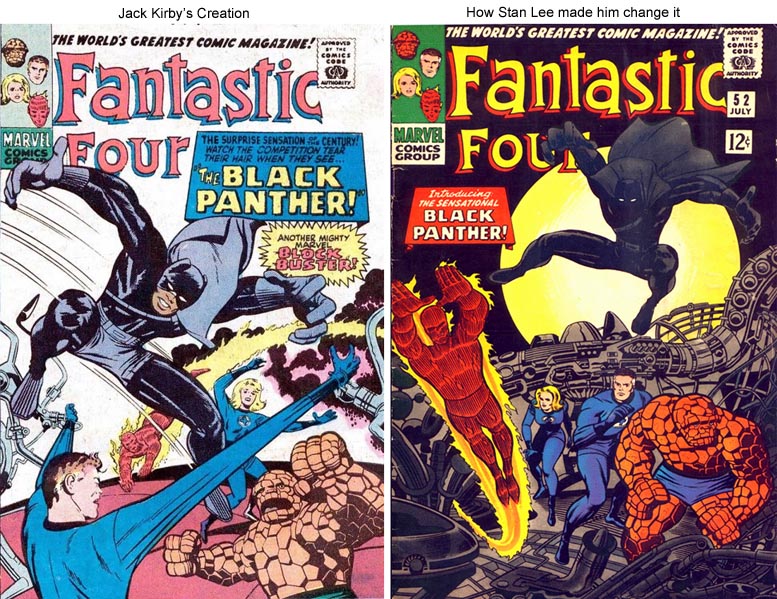
Why cover his face? Perhaps to be a big reveal? Perhaps because he
was a man of mystery? But so was Black Bolt, so was Gorgon, Galactus,
the Silver Surfer, and pretty much every Kirby character from this time
period. Only the black guy has to hide his face. Why? Well, whenever
comics showed a black character (in this period), they got letters of
complaint.
“‘comic characters are a white man’s land,’ admits Alfred Andriola, artist and co-creator of Herry Drake, ‘let’s face it. you can’t deal with race or color in comics. a colored maid or porter brings on a flood of letters. and if we show the negro as a hero we get angry letters from the south.’” (Source: "How The Funnies Handle Race", Ebony, November 1966, just a few months after FF 52.)
So black characters were seldom seen. And when, four years earlier, DC reprinted a British adaptation of a movie that had some black people ("Dr No"), they recolored the black faces to be white. (source).In his defence, Stan did allow T'Challa to take off his mask at the end of
the story. But by then the comic was paid for and hopefully the reader
liked it. And after that black characters became a little more common.
"There may have been some internal hand-wringing about the Black Panther. The first version of the cover had shown the Panther's black skin; the published version did not. Previews in other titles that month suggest Marvel couldn't decide how much of him to show-or how to characterize him. "Don't miss the mystery villain of the month!" read the ads, which blocked out the cover art. (Once Marvel committed to a policy of representing black characters, however, change came quickly. The cover of the following month's romance comic Modeling with Millie proudly introduced a black British model named Jill Jerold to its cast." (source: Marvel the Untold Story)
Hot coals of vengeance!
Coal's main property is that it burns! Being black is only secondary.
And when it burns it's red on the inside, like TChalla's cape. To better
understand the
symbolism of coals, look to Shakespeare. Occasionally it means "coal
black" or red, but usually coal refers to fire, and passion, and
vengeance!
To make coals cheap,--a noble memory! Coriolanus: V, i
And all eyes else dead coals! fear thou no wife; The Winter's Tale: V, i
Your breath first kindled the dead coal of wars King John: V, ii
There is no malice in this burning coal; King John: IV, i
The cat, with eyne of burning coal, Pericles, Prince of Tyre: II, v
That I have blown this coal: I do deny it: King Henry VIII: II, iv
Than is the coal of fire upon the ice, Coriolanus: I, i
Men would carry coals. they would have me as King Henry V: III, ii
Is kindling coals that fires all my breast, King Henry VI, part III: II, i
If he could burn us all into one coal, Coriolanus: IV, vi
Hot coals of vengeance! let no soldier fly. King Henry VI, part II: V, ii
Have blown this coal betwixt my lord and me; King Henry VIII: II, iv
Faith, at the latter end of a sea-coal fire. Merry Wives of Windsor: I, iv
At the round table, by a sea-coal fire, upon King Henry IV, part II: II, i
And add more coals to cancer when he burns Toilus and Cressida: II, iii
A coal of fire, sometimes plue and sometimes red; King Henry V: III, vi
Gregory, o' my word, we'll not carry coals. Romeo and Juliet: I, i
Look at T'Challa's story: he is smouldering with vengeance since Klaw
murdered his father long ago. He is like a fire that will not go out.
Shakespeare would have understood the name. I could also go further back
and cite hot coals in the Bible (what with Kirby being Jewish) but I
hope I have made my point.
Tigers are cooler than panthers (and less racist)
The name "tiger" suggests strength and beauty. But "panther" is more
about being black (panthers are black). And to make it super clear, Stan
wanted "black panther": or "BLACK black cat". Add the totally black
costume and it looks like Stan saw T'Challa as just one thing: black.
T'Challa was being defined by his skin color.
What our reaction to "coal tiger" says about us
Everyone seems to think "coal tiger" refers to skin color. But do not
take the same approach to white people. Is Emma Frost (the White Queen),
named "Frost" because of her frost-white skin? No. The color is
not the point, its about coldness (just as coal is about heat).
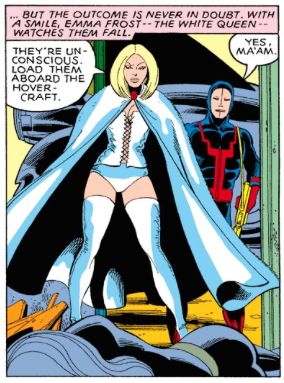
Is Pinky Pinkerton (of the Howling Commandos) named for his pink skin? No, other connotations of "pinky" are more important.
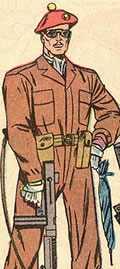
The political name
The name "Black Panther" later caused problems because it was also the name of a controversial political group,. So in FF 119 Stan tried to change it.

That was just bad luck, right? The Black
Panther party did not begin until October 1966, a few months after FF 52
came out. But it got its name from a black panther party that was
active in Alabama in 1965 (source)
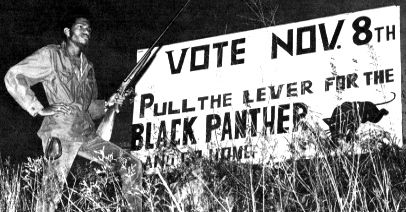
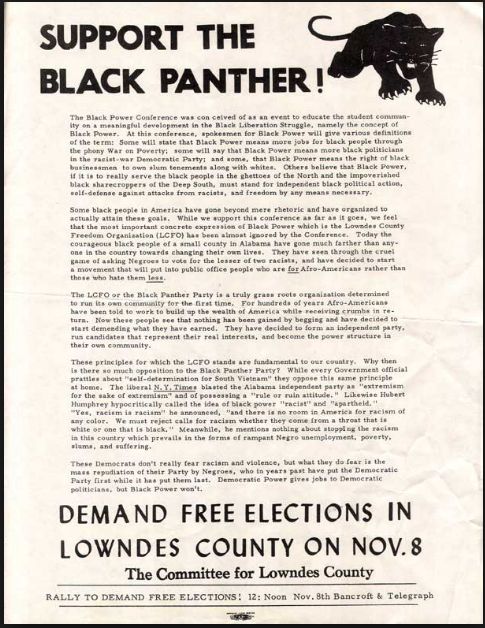
In 1966, shortly before FF 52 was created, the New York Times ran an article about that Black Panther party (source).
Jack Kirby was an avid reader and observer of trends. So Jack avoided
the naming problem. But Stan Lee walked right into it and later
regretted it.
The problematic costume
Jack Kirby's costume doesn't look as good as Stan's idea, right?
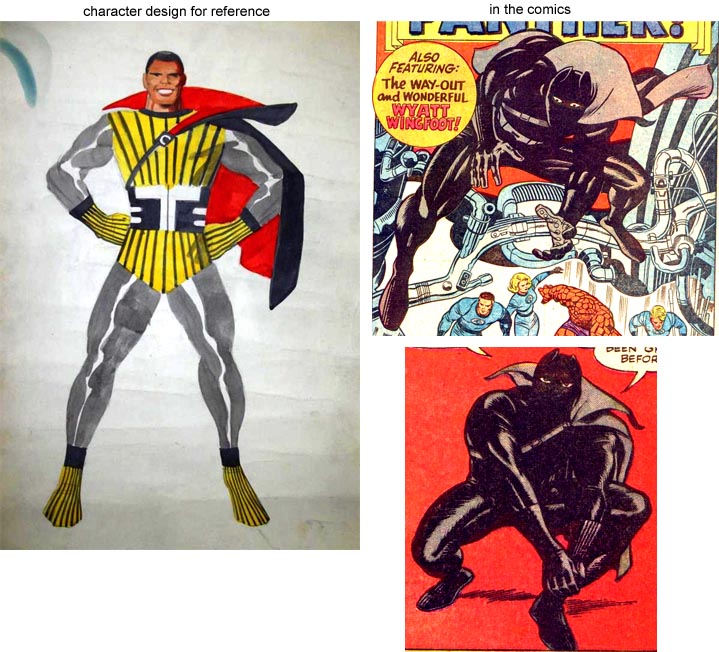
But look closer: it's the exact same costume, complete with side
cape, strap, stripes on the gloves and boots, and so on. The only
difference is the absence of color, and removing the tiger stripes on
the torso. Sure, Jack's character design looks garish, but it's supposed
to: it is a reference design, for the purpose of highlighting details.
The finished comic shows how it looks in practice. All Stan did was make
it all black. Jack's version would have looked exactly the same, but
with a splash of color. Was removing color a good idea? Aesthetically
it's is a matter of opinion. Some people will prefer one, some the
other. But again it opens Stan up to the racist charge. This is why:
When Jack thought of T'Challa he thought of a tiger! The symbol of strength and beauty! His costume was bright and proud! Look at authentic African costumes, they tend to be highly colorful! Kirby's instincts were spot on. But to Lee, African meant just... black, black, black.
In Jack's cover, T'Challa is big, bold, proud, in control! But Lee pushed him into the shadows. Throughout history, white people have preferred that black people stay hidden. I don't suppose Stan Lee intended it that way. It's just another unfortunate accident, along with the full face mask and political connotations. But Stan has a lot of these accidents, and Jack doesn't.
The question of creativityFinally, Stan's name change and costume change caused a problem because there was already a character called the panther who had an all-black costume, from Two Gun Kid issue 77. Reusing it just creates confusion.
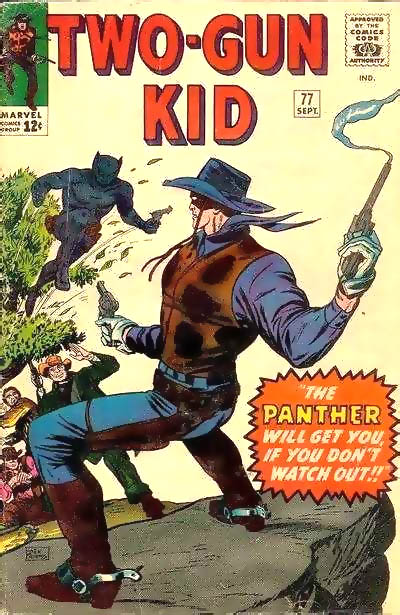
However, this does allow us to make a useful comparison. Here we have two "black panther" characters, and the only difference is that one is entirely by Stan Lee and the other is by Stan Lee with Jack Kirby. The Stan Lee character is a guy who dresses up in a costume to scare people. It was instantly forgotten. But add Kirby to the mix and we have a character who makes history (first black superhero), with a rich and fascinating back story, who supports his own comic titles over the years, and is about to become a major Hollywood movie (I write this in July 2016). So what does the black Panther tell us about who contributed what? You decide.
Lee's position is not under threat
This is starting to sound like an attack on Stan Lee. So again I must
emphasise Lees' achievements. Stan made the business work. Stan
connected different creators' stories and thus created the connected
Marvel Universe. Stan raised the profile of artists and writers, and
tirelessly built an audience of millions. Stan wrote easier to read
stories. Stan connected with people in a way that Jack Kirby could not. Stan deserves his millions and his fame. But this page is about a narrow question: who did what in writing the Fantastic Four?
There is plenty of evidence Kirby plotted the later issues (marginal
notes, Stan Lee's comments, etc.). But some people think he did not plot
the first 20 or so issues:
"The earliest Fantastic Four page scan that I can find with Kirby’s notes is from F.F. Annual #2, appearing in the summer of 1964. Comic Book historian, Nick Caputo concludes that the Jack Kirby’s margin notes first appear in The Avengers #6, dated July 1964. If one looks at the notes in the upper margin, it is clear that it is Kirby’s lettering. Thus we can probably date the beginning of the Marvel Method to this approximate period." (source)
However, other collectors do have evidence of earlier notes. James Robert Smith refers to Hulk 4, which has the same cover date as FF issue 8:
"It was when I was collecting Silver Age artwork in the late 1980s that I realized that it was Jack Kirby all along who was writing the books Stan Lee claimed to have written and created. My earliest pages were from Incredible Hulk #4 and it was obvious from the hand written notes from Kirby that he was writing the book and Lee’s only contribution was in sometimes pumping up the dialog. Lee was an editor. A very good editor, but nothing more than that." (source)
Inkers would of course erase the pencils, so any notes within the panels (and sometimes the others) would be gone.
"I have a
Kirby / Romita Daredevil page where a prior owner erased Jack's pencil
notes. Kirby's notes sometimes differed from Stan Lee's final balloons/
captions and it's fun to see how the match or don't." (source)
But Kirby's writing is mainly through his
art. Most pages in the early issues did not need additional notes: you
can remove the dialog
and still see what is going on. But as Kirby's stories became more
cosmic then additional notes were needed.
Here's a good example of the earlier issues needing fewer notes: the last page of FF 40:
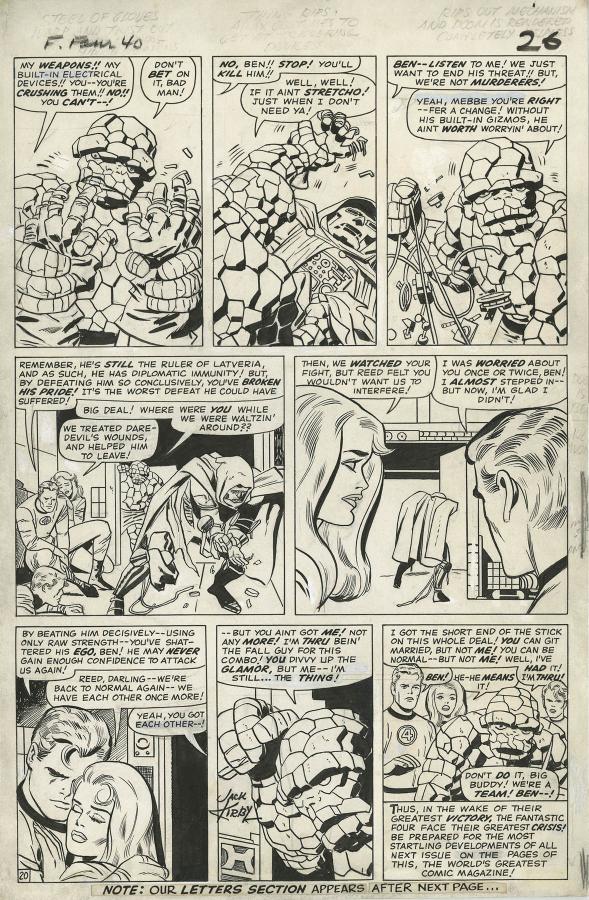
Noe that the notes have been erased. But in this case they still show through a little, so I have enhanced them:
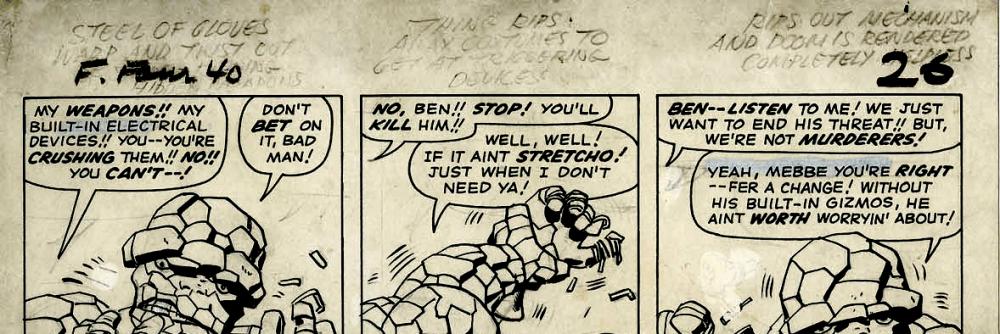
Compare this story to the page shown earlier. This story is from an earlier year, is less cosmic. So it is easy to follow even without notes.
 |
This example shows |
On a tangent, I saw this page on an auction site. The current bid is $15,000, and there are still three days to go.
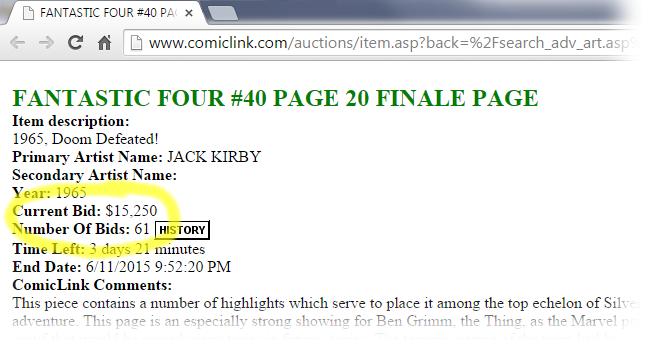
How much was Kirby paid for this page? What fraction of that $15,000?
According to John Romita, the page rate at the end of the 1950s was cut
to $24 (see Icons of the American Comic Book" p.412). It may have gone
up a little by 1965, but probably not by much. That's all Jack Kirby's
family ever saw.
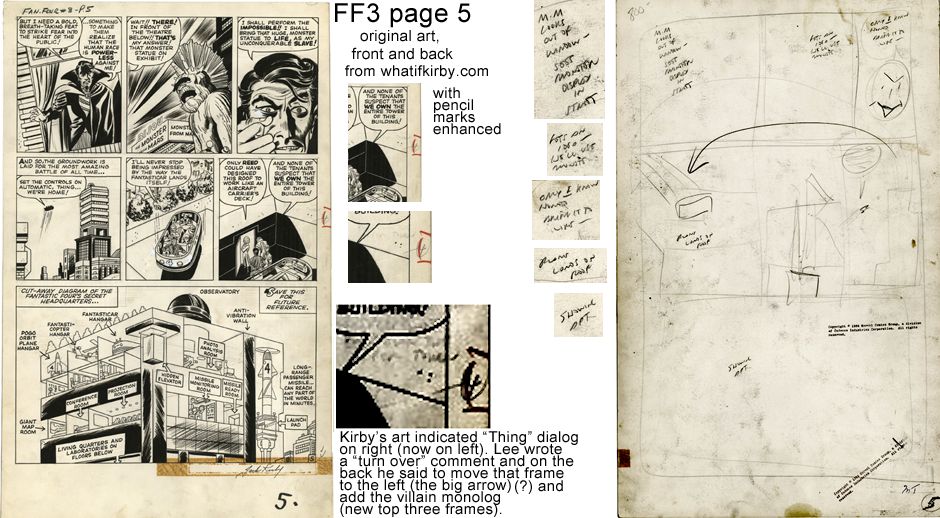
It looks like Stan was asking for a change. Note the big arrow: he
wants something moved. And note the pencil writing on the original frame
the arrow referred to: it's hard to make out what the original dialog
was supposed to be, but the last word is definitely "Thing" - a word
that now appears in the first frame. So it seems most likely that, for
that arrow, Stan was just asking for the last panel to become the first
one. It also looks like Stan added the whole sequence at the top.
The pacing in the top half of the finished page, and the bottom half of
the previous one, is odd. Lots of jumping around without it being clear
how each image leads to the next. Kirby generally drew like a movie,
where each frame leads to the next. So here is what I think
happened:
If we start from the premise that Kirby's art tends to move smoothly
from frame to frame, then page 4 somehow got the team from the fight at
the theatre to the new headquarters on page 6. So I presume the
headquarters diagram on page 5 was originally there, and the two half
pages in between somehow got us from the fight to the headquarters. The
sequence probably focused on Ben's anger: Kirby tends to fill his
stories with action, and Ben's anger was a big deal in the early issues.
Stan would have looked at this and thought "we are five pages in and
haven't seen a clear direction with a clear hero and villain". He wanted
to emphasise the Miracle Man as an individual, and make a contrast with
Reed as an individual. So in his changed version we get close ups of
both men: Reed sums up the conflict (the one foe they could not defeat),
the Miracle Man has a monolog, we get a foreshadowing of the
monster, and it ends with Sue saying how wonderful Reed is. That's all
classic Stan (in my opinion, based on Stan's solo comic writing).
I think this was a good change, and illustrates what Stan added to the
the story: he made it clearer and more personal, All of Stan's stories
are clear and they are personal: as people often say, Jack provides the
divinity, Stan adds the humanity. With Stan we always know who the good
guys and bad guys are, we always feel close to them, and we never get
lost.
Contrast this with what we know of Kirby's solo work. On usual monster
stories (Jack's previous work) we don't have time to get to know the
characters very personally (the whole thing has to be over in 8 pages).
When we look at Kirby's later Fourth World stuff it's the same: all
cinematic action, but sometimes hard to follow, and readers don't feel
an intimate connection with the characters as friends.
I think Stan's changes here are a good example of why he was needed,
even though the changes break the smooth flow. Kirby created the story
(after a chat with Stan, were Stan was the boss). Then Stan sometimes
asked for changes. Then Stan scripted the dialog, just as he explained
back in 1947, and just as we see from the notes on later pages.
Kirby said he basically created everything, more or less. Some people say he exaggerated. This is their case:
Those claims will now be examined in depth.
In researching this page I tracked down every Kirby interview I could
find, and he has always been consistent: he created the plots, and
always did it that way (at least with regard to Marvel). the best early
interview I can find is from the 1970 comic convention a few months after he left Marvel. It's only available in audio, but it is good to hear Kirby's own words, so I clipped out a couple of relevant pieces. Click to hear Kirby say it himself:
Kirby in his own words: he always created his own stories
(the audio is poor at the start, but Kirby's answer is clear)
Kirby is fair. He implies that Stan did have some input, at least in the earliest issues days. In this clip he simply says that he (Kirby) simply "had a hand in" creating Doctor Doom:
Kirby in his own words: on creating Dr Doom (and not creating the Red Skull)
(He also refers to Edward Herron, who co-created Captain Marvel Junior.)
The comics tell their own story
Even if Kirby had said nothing the comics speak for themselves. Right from the start it is clear that Lee's dialog often contradicts Kirby's art. That is, Kirby is not drawing what Lee wanted, but Lee is adding text afterwards.
We see this most clearly with Sue Storm. Kirby draws her as an equal partner, able to defeat enemies on her own. But whenever Kirby does that, Lee adds dialog saying that really it was Reed's doing, even though it makes no sense in context. I mean, since when was Reed a world class judo expert? But Lee seems to be thinking of old style superhero stories where the male lead is always The Greatest Hero and everything must be by him. Kirby's respect for strong women is inspiring, but Lee's sexism now looks very dated.
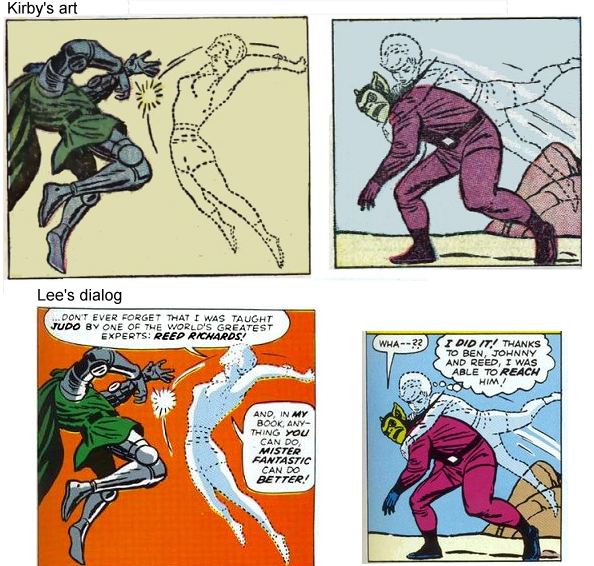
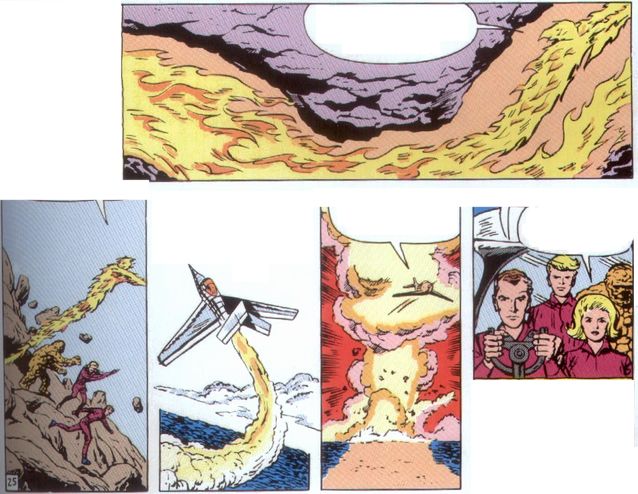
Kirby's memory of how he joined Marvel has been used as evidence that Kirby is not reliable. Let's look at that claim. Wikipedia sums up Kirby's claim and Lee's counter claim:
"[Kirby] recalled that in late 1958,
I came in [to the Marvel offices] and they were moving out the furniture, they were taking desks out — and I needed the work! ... Stan Lee is sitting on a chair crying. He didn't know what to do, he's sitting on a chair crying — he was still just out of his adolescence [Note: Lee, born Dec. 28, 1922, would actually have been about 36.] I told him to stop crying. I says, 'Go in to Martin and tell him to stop moving the furniture out, and I'll see that the books make money'.
The interviewer, The Comics Journal publisher Gary Groth, later wrote of this interview in general, 'Some of Kirby's more extreme statements ... should be taken with a grain of salt....' Lee, specifically asked about the office-closing anecdote, said,
I never remember being there when people were moving out the furniture. If they ever moved the furniture, they did it during the weekend when everybody was home. Jack tended toward hyperbole, just like the time he was quoted as saying that he came in and I was crying and I said, 'Please save the company!' I'm not a crier and I would never have said that. I was very happy that Jack was there and I loved working with him, but I never cried to him. (laughs)"
Were they moving out the
furniture?
The furniture anecdote was told decades later. At other times
Kirby said it like this:
“Marvel was on its ass, literally, and when I came around, they were practically hauling out the furniture,” Kirby said. “They were beginning to move, and Stan Lee was sitting there crying. I told them to hold everything, and I pledged that I would give them the kind of books that would up their sales and keep them in business.” (Sean Howe, "Marvel the Untold Story," prologue)
Note the word "practically" and the context "they were beginning
to move." The Wikipedia article on Atlas comics (Marvel's name at
the time) noted that Kirby's first work was to freelance "on five
issues cover-dated December 1956 and February 1957" but he did not
do other work until he was formally hired in 1958, then his first
published work was cover dated December 1958. Between those times
the company lost its distributor and so its output crashed. The
article quotes Stan Lee:
"[We
had been] turning out 40, 50, 60 books a month, maybe more, and
[now] the only company we could get to distribute our books was
our closest rival, National [DC] Comics. Suddenly we went ... to
either eight or 12 books a month, which was all Independent News
Distributors would accept from us"
This led to many lay offs. The article quotes Joe Sinnott:
"Stan called me and said, 'Joe, Martin Goodman told me to suspend operations because I have all this artwork in house and have to use it up before I can hire you again.' It turned out to be six months, in my case. He may have called back some of the other artists later, but that's what happened with me.
So they went from needing enough people for sixty titles a month
to needing nobody for a while, then needing a much smaller staff.
Obviously fewer desks were needed, so Kirby was right about this
general period: yes, they were moving out furniture.
Did Stan Lee cry?
Stan Lee was known to take it personally when he had to bring bad
news to staff. He genuinely cared, and felt it deeply when bad
things happened, as recorded in Howe's "Marvel the Untold Story"
and various interviews. And one man's depressed sniffle is another
man's "crying." So this may be just shorthand for how Stan was
obviously feeling at the time.
In short, Kirby does not contradict Lee in any serious way. It's
all a matter of interpretation.
The written synopsis to issue 1 still exists. it's very brief, just 2 pages in the copy that is printed in FF358, and 4 pages in the copy printed here. This synopsis is sometimes used as proof that Stan Lee came up with all the ideas.
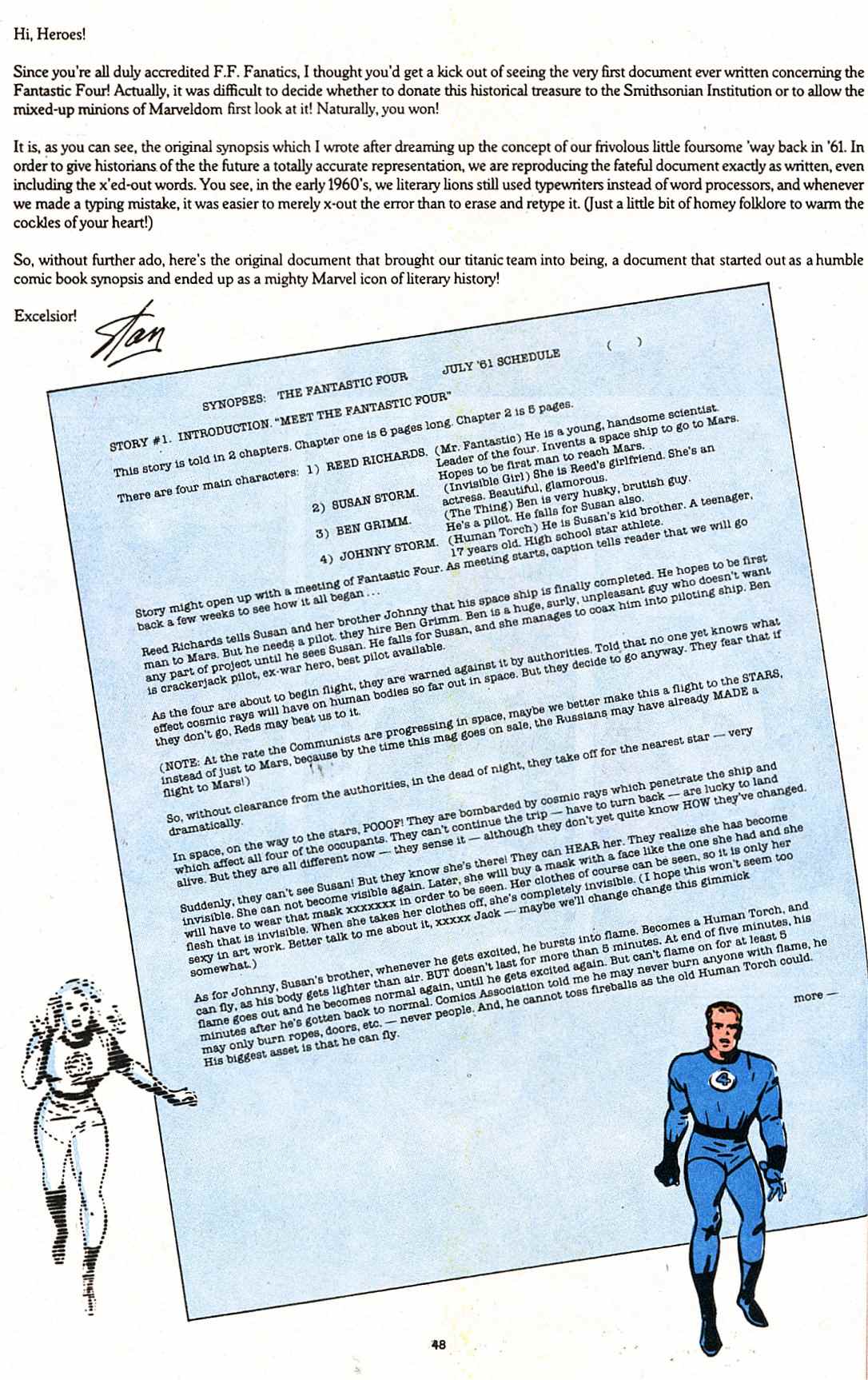
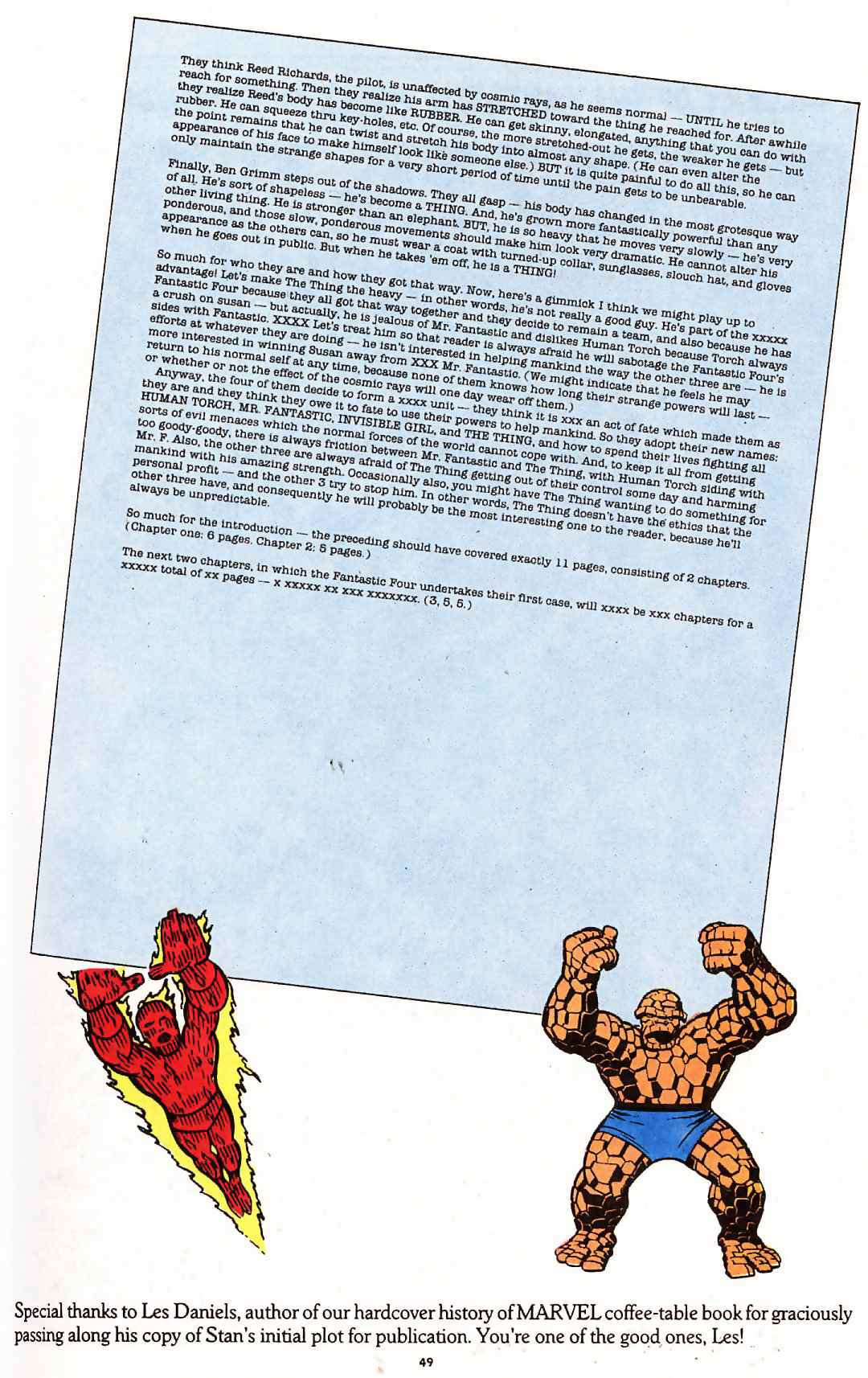
Stan Lee talked with Jack Kirby about the Fantastic Four before this summary was produced. According to Mark Evanier, Kirby's long time assistant:
"It
[FF issue 1] feels an awful lot more like Jack’s earlier work
than anything that Stan had done to that date. So I find it very
difficult to believe that Jack did not have input into the
creation of the characters prior to the — that synopsis,
whenever it was composed. And, also, I have the fact that I
talked to Stan many times, and he told me — and he said it in
print in a few places — that he and Jack had sat down one day
and figured out what the Fantastic Four would be."
Stan himself said in Origins of Marvel Comics,
"After kicking it around with Martin and Jack for a while, I decided to call our quaint quartet The Fantastic Four. I wrote a detailed first synopsis for Jack to follow, and the rest is history." (emphasis added)
But years later, in 1991 when Marvel was in legal conflict with Kirby, Stan gave a different version of events:
"I
didn't discuss it with jack first. I wrote it first, after telling Jack
it was for him because I knew he was the best guy to draw it." (source: an interview with Roy Thomas in Alter Ego, the Comic Book Artist Collection)
Did Stan remember accurately? Probably not. His poor memory is notorious. It was always bad, as he admits himself.
"I even
had a bad memory when I was young. I'd call him "Bob Banner"
instead of "Bruce Banner," etc. I hadda give out a heap of
no-prizes!" (source)
Steve Sherman, assistant to Jack Kirby, said:
"I asked Jack about that synopsis. He told me that it was written way after FF #1 was published. I believe him." (source)
Why would a synopsis be written after the event? That is normal in
business. The boss discusses something with the workers, and it is
written up as a series of instructions. Let's take a closer look.
Provenance
The above synopsis is a re-typed copy. See the XXXs: originally
those had words underneath. Stan typed Xs to delete a word. But
this version only has the Xs. Another version has no XXXs at all. So neither is the
original. I have seen a third that claims to be the original, but none of them were public until the 1980s, over 20 years
after FF1 appeared. Roy Thomas, (in his book "The Stan Lee
Universe") mentions seeing the synopsis in "the late 1960s." It must have
been 1968 or 1969, as Roy said the cover price had just gone up to
15c and he wondered if Stan was calling him to talk about another
price rise. But Stan instead showed him this synopsis he had just
found. Stan said he did not keep his other typed instructions, and
it was pure luck that this one survived. In the book Roy also
refers to one other early script (for issue 8). Like this first one it
was not a script in the usual sense.
"I remember seeing that synopsis (to
FF 8) in Jerry Bails’s house when I came to Detroit to visit
him. I said, 'This is a script?!?! You just give the artist some
sort of synopsis and then the guy goes off and draws it and then
he adds balloons? What a crazy way to do comics!' Now of course
I think the fact that they’re not done that way anymore is one
of the things that’s wrong with comics." - Roy
Thomas
Apparently none of these early synopses survive, despite the
hundred of comics written in the early 1960s, and the interest of
fans such as Roy Thomas and Jerry Bails. Presumably "scripts" were
very sparse, if they were written at all.
Accuracy
Much of the synopsis contradicts the final version. For example,
about Sue being permanently invisible, Johnny not throwing
fireballs, Reed feeling pain when he stretches, and the emphasis
on the Ben-Reed-Sue love triangle.
Similarity to Challengers of the
Unknown
Many have noted the similarity to Jack's earlier comic for DC,
Challengers of the Unknown: a s similar origin, four friends who
roughly represent the four elements, etc. The Challengers even got
super powers in issue 5, including one like the Human Torch.
Three references to Mars
Fantastic Four 1 was planned for July 1961 (though cover dated
November: that was normal at the time). This means it would be
planned in April, the exact same month that the Russian Yuri
Gagarin became the first man in space. But it was inspired by the
success of Justice League, which first went on sale cover date
March 1960. So they were thinking about superheroes before April,
and from April the space race suddenly hots up. Note the changes
between the published issues 1 and 2. Issue 1 is vague about
merely going "to the stars" and actually gets no further than the
atmosphere. But in issue 2 they refer specifically to Mars. Before
April 12th, when the news broke, the fear was just that the
Russians would get into space. After April 12th the concern was
for the next step: to the Moon, and if the Russians got there
quickly, then to Mars. This hints that FF 1 was plotted before
April 12th, or certainly before the significance of the news had
sunk in over the following weeks. FF 2 was of course written after
the Russians "next step: the Moon" was well known. It may be
important then that the synopsis mentions Mars three times. It
suggests that the synopsis was written after FF was drawn and
scripted, but not long enough after for "relax, the Russians are
nowhere near the moon yet." This is consistent with the normal
course of events: writing a synopsis of a meeting after the
meeting.
Tone
The tone is verbose, even chatty. He gives reasons for creating
ideas. Why give these in a script? Why not just say "make the guy
flame on" - why the need to say "here is proof that the ideas are
all mine, and this is my reasoning"? If he is just chatty then why
not chat about the other parts of the story?
The smoking gun
The "synopsis" only covers the origin. The finished comic is in
three roughly equal parts, and the synopsis acknowledges that, but
dismisses the first part in a single line and does not outline the
final part at all. Even if we go with the theory that
this was the original script, with no input from Kirby, that
means Kirby wrote two thirds of the book on his own, and the
rest was greatly changed.
Stan Lee understood the business of comics. So he would know that
this particular issue had legal implications, so he needed a paper
trail.
He knew the comic might be noticed
At the exact same time the comic was being written and drawn, Yuri
Gagarin became the first man in space. The news broke on April
12th 1961. This was HUGE news. The space race was already hot, but
this made it WHITE hot. Stan's "first into space" comic was
suddenly topical. This had legal implications, because Stan was
planning to slip the book under the radar of his competitors.
He knew that National (DC) had reason to complain
Marvel was planning a superhero team, but DC distributed their
books (they lost their own distributor in 1957 in the Frederick
Wertham anti comics crusade). DC was happy to take their money
because Marvel at the time didn't produce any superheroes that
might compete for sales with Batman and Superman. Worse, FF 1
looks like Challengers: it might look like Marvel had taken Kirby,
formerly a DC artist, and got him to copy his own DC title! The
distributors would not be happy. The synopsis seems designed to be
insurance against these claims:
The synopsis looks designed to cover his back
The Synopsis would come in useful if either Martin Goodman changed his mind or DC found out and were not happy.
Ben is a monster who is angry and lashed out at his friends - this is a monster trope, not a superhero trope.
Sue is always invisible, with an emphasis on masks and changing clothes, clearly based on H.G.Wells' The Invisible man, not a superhero. (Incidentally, Wells was a socialist, and the invisibility that drive him mad is widely seen as a metaphor for the invisible underclass. Note the later parallels with Sue: the most powerful member yet seen as the weakest.
Reed is in pain when he stretches, like a horror character, not a superhero.
Finally, Johnny cannot control his flaming, it only happens when he's excited and then dies down. And he does not throw fireballs. Like the others he fits in a weird tales book, not a superhero book.
It was no big deal
This need not be a conscious decision. Stan just had a gut
feeling that he should have a written copy. It's a common feeling
in any business. Stan understood business, this would be an
automatic response, the work of a few minutes. It does not require any
conspiracy.
"We should discuss"
The synopsis says "we should discuss this" - does this imply
it was before the meeting? It was before any lengthy
meeting, certainly. But most of these elements (the love
triangle, how easily they changed, etc) were vague in issue 1.
They were not set in stone until later issues.
Is it dishonest to say "do this" after it is already being
done? No, these are minutes, a paper trail. It's a faithful record of
what was said, from Stan's point of view. And a record of the
same event from Jack's point of view would have had the same
general ideas but in a different way.
Does "do this" and "do that" prove it was all Stan's idea? No, that's just good business. You have to make actions crystal clear. I sometimes make web pages for others, and the synopsis reminds me of the emails I get later: "you will do this, you will do that" - those emails reflect meetings where I actually made the suggestions, as I was the one with the expertise: the client was the one wanting "a web page," but then took my advice at every point about what was possible, what would work, etc. But he was the one signing the check, so the final document had to say "you will do X". I was the creator, but he was the master.
Conclusion
The famous synopsis was probably written a few hours (or at most a few weeks) after the initial
discussion, but Kirby never read it. The synopsis is minutes of a meeting, presented after Kirby gave
his input. It only deals with those elements that might cause legal trouble
later, and tries to show that DC has no reason to complain. In
short, this is not a synopsis, it's a defense against DC. Years later it became useful in the legal battle against Kirby.
Stan searched for it, and found it in 1969 when Kirby was
grumbling about deserving more pay. it then became widely
published in the 1980s when Kirby was talking about suing Marvel
We know of just one other early synopsis: for issue 8. Roy Thomas
refers to it in the book "Alter Ego, the Comic Book Artist Collection". Here are Roy's words and my comments.
"As I said earlier the synopsis for #1 wasn't the first FF plot I'd seen."
[ Roy was Stan's right hand man since 1965, yet this was worth him commenting on: apparently he only saw two written FF synopses in all his years there.]
"Over Thanksgiving weekend in 1963, while the nation mourned the assassination of President John F. Kennedy the week before, I took a train from St. Louis to Detroit to spend a subdued holiday with Jerry balls, college-prof founder of Alter Ego."
[Jerry Balls pretty much invented fandom as we know it: he kept writing letters to the comics asking for information. He was probably the first person to ever ask for a script.]
"'Knowing' that comic book artists always worked from a script as detailed as a Hollywood screenplay, I was surprised to see that what Jerry had received was merely a plot, its first page covering the initial 13 pages of the comic, and that it was clearly meant as a blueprint from which the artist would break down the tale into pictures. 'Marvel artists work from this?' I asked. Jerry said apparently so: Stan added dialog and captions later. I shook my head. it seemed to me like a helluva way to run a railroad. (Yeah, as it turned out - a good one!) Evidently Stan trusted artists like Kirby, Ditko, et al, to both pace out and flesh out the story."
[So this is never in question: the artists did most of the "writing" work.]
"Truth to tell, neither Jerry nor I can recall whether he ever possessed the entire synopsis, or merely the first of two pages - [because] he retyped and printed only page one. Jerry feels that, if he'd had the whole synopsis, he probably would have printed both pages.
[So the only two synopses we have only deal with the key 11 or 13 pages, and are highly compressed. This agrees with Kirby's memory that when a person suggested a comic to a potential client they only roughed out the first few pages.]
Now let's look at that synopsis in detail:
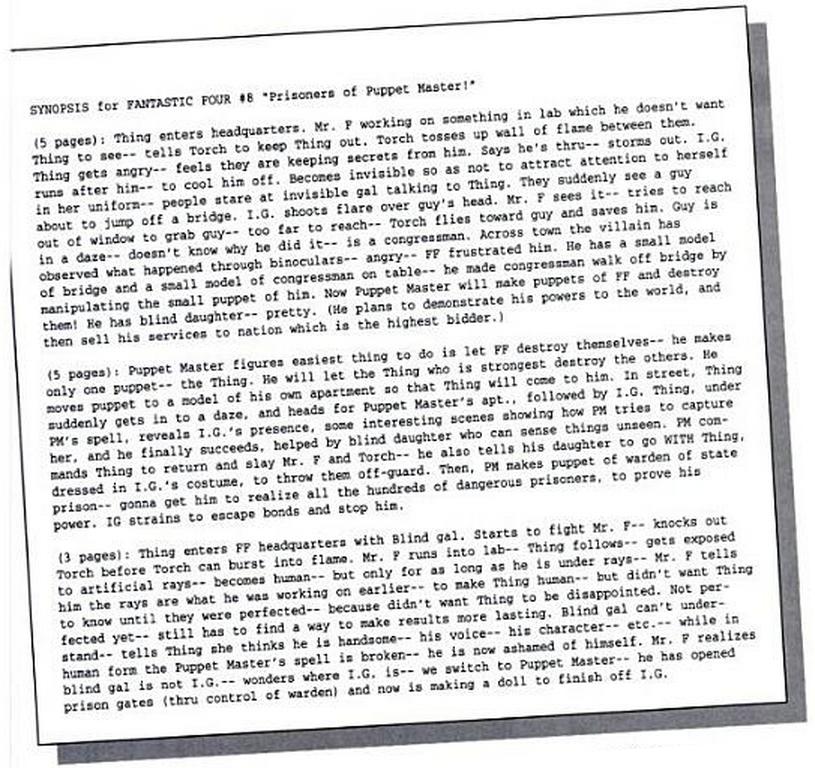
It is fascinating to compare Stan's synopsis to Jack's finished art. Jack's version of the story is...
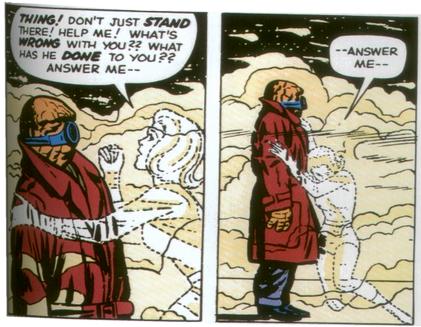
We do not have audio of the original story conference so we cannot know how much Stan came up with.
We do have his dialog, but that generally just states what is already clear from the art. Stan is very good at making the story simple and obvious: this is clear in Kirby's later Fourth World books. They are wonderful to study, but without Stan's easy dialog they are too intense for most readers.
In my opinion, Stan was excellent at turning out comics quickly. His
stories had familiar tropes (the hero always wins, the woman always
needs rescuing). His stories were very easy to follow. But they were
"just comics": a throw away, undemanding medium. Jack added the depth
that made the comics something more.
Balls asked for a script in November 1963. Stan would have just finished FF 25 or 26. So why send such an old script? Wouldn't a more recent one be easier to find? And why has nobody ever seen another "script"? Nobody who worked there has ever recalled seeing another script (for Kirby at least - other artists may have needed them)? We only have evidence that two synopses ever existed.
I think the key is to compare the stories before issue 8 with stories after: the early stories usually feature outer space (issues 1, 2, 6,7), the team fight amongst themselves, and super powers are not needed (all stories would work without them). All of this changes after issue 8: the stories become lighter, more conventional superhero stories set mainly on Earth. (This also coincided with the stories going monthly after issue 7).
Now examine issue 8 without the dialog. Look at the previous issue first. Look at the Puppet Master's head. Look at Kirby's previous stories in other comics about puppet masters and robots. It seems to me that the Puppet Master was not intended to be fully human, and Alicia was to be a puppet or automaton of some kind. Add the suicide and mind control and this is a dark story. My guess is that the "synopsis" is Stan's instructions for Kirby to make changes so the story is lighter. The fact that he had to put it in writing shows how strongly he felt. After this the stories lighten up, and do not become dark and cosmic again until Stan becomes too busy to edit as much, starting around the 40s. I discuss this theory in more detail on the page about issue 8.
It's just a theory. Maybe there were other synopses that were all lost. Or maybe, as some have suggested, when Balls requested a script, Stan just pulled the first comic he could find, flicked through the pages without reading carefully, and wrote something then and there. Who knows?
In summary, Stan's dialog was very easy to follow.
Beyond that it is difficult to say what he added. However, his fame does
not (or should not) rest on his stories, but on his abilities as an
editor and promoter. Nobody else has ever edited and promoted like Stan. That
is Stan's real genius.
The following is by lornelb of the FF forum,
and reprinted by permission. Somebody asked why we see so much
negativity about Stan Lee among fans.
"The reason you don't find any negative blogs about Kirby is that this whole "Lee vs Kirby" debate arises because of the perception that Lee has somehow cheated Kirby and made himself rich, while Kirby died penniless.
The whole narrative rises from that notion.
Stan is portrayed as the Hollywood Huckster, who had little to no input in the comics that made him rich, beyond "signing his name larger than everyone else's".
Jack is portrayed as the true genius who conceived, drew, and wrote everything with little to show for it at the end of his life. Under those circumstances, there wouldn't be much sense to an anti-Kirby blog.
Even Kirby's stories about coming into the Marvel offices as the furniture was being moved out and Stan crying at his desk, untrue though everyone else has stated them to be, doesn't generate much anti-Kirby sentiment, because he is, by far, the more sympathetic of the two.
Kirby can claim to have written everything and Stan, nothing, and be contradicted by the writers and artist working at Marvel at the time, and still not be vilified, because his creative genius is beyond question.
The way the industry was set up then, the work for hire credo insured that most creative types would have little more than their contracted pay rates to show for their work.
The problem for me is that vilifying Stan for the way the comics industry existed while the two worked together, is completely misguided.
Stan's vision and innovations (including non-innovations like copying EC's style of promoting it's artists) completely changed the comic book publishing industry forever. Without Stan's editorial vision and scripting, the Fantastic Four (nor ANY of the Marvel comic characters that he scripted, including Spider-man) doesn't create the sensation that they did amongst comic book readers.
In a world without Stan, the average comic book reader is an 8-14 year old boy who stops reading comic books when he discovers either girls or porn; the artists who fall into comics would still be largely working under pseudonyms (Check with Jacob Kurtzburg about that [Jack Kirby's real name]); working until their eyesight failed because a lack of medical or financial retirement benefits in an industry that probably wouldn't have lasted past the first huge hikes in paper and ink costs in the early 70s.
There certainly wouldn't be any websites like these, created by educated fans who retained their love of the medium and were confident enough in the attractiveness of the medium that there would exist like minded fans with whom they could communicate.
There are any number of far more talented creative types who have worked in comics than Stan Lee, including Seigel, Shuster, Kane, Kirby, Eisner, Moore and dozens of others. But not one of them can claim to have had as great and far reaching an effect on the medium overall as Stan Lee did. With his innovations to comic book scripting (I think far too little credit is given to Stan for his skill at writing dialog, which not only included biblical and Shakespearean elements, but included an great ear for being able to distinguish one speaker from another in the same panels) and his vision of a unified, continuous comic book universe, Stan Lee changed the entire industry.
It is also Stan's idea of a unified universe and continuity that created the modern notion of comic book collecting. With the use of the footnote (Something Stan used copiously to reference previous storylines and character appearances), constant references to previous adventures, continued storylines, and cross-overs, Stan created a necessity for readers to retain their prior issues for reference. This was never the case before, where comic book stories mostly, outside of the same characters appearing in the same outfits, were written as if each new story had no connection to any previous storylines. Stan's use of continuity also created the desire in newer readers to find those referenced issues so that they could see what was going on. In this way, Stan pretty much took comic book collecting out of the province of eccentrics and rich Arabian child princes and made it a common practice. From this arose stores dedicated to comic books and back issue mail order companies.
None of the forgoing can be attributed to Steve or Jack. They had been plying their skills in the same manner for some years before the so-called Marvel Age. It wasn't until Stan expanded the EC model of fan inclusion and artist recognition using his own breezy, accessible editorial voice (His detractors call this "hucksterism"), that comic book fandom took off. As a case in point, seven years after Stan and Jack first published FF#1, Jack's name was known to even the most casual of comic book readers. Could the same be said for Graham Engels, or Johnny Craig, two of EC's mainstays?
In the final analysis, Jack will always be seen as the person who was ill-served by the industry and the very Publishing House that he helped promote from a ill-regarded, lowest rate paying, shady publisher having, juvenile delinquent catering cesspool, into a billion dollar industry worthy of being owned by Disney.
But, because Stan managed to help change that perception and also appears to be prospering at the end of his life, doesn't mean that he is the villain of the piece, or even somehow responsible for Jack's circumstances.
Jack was bursting with ideas, but he was also impatient, bitter and distrustful (rightfully so). Jack also knew the nature of the industry he chose to work in. Had Jack been able to hold out against Goodman's "promises" long enough, I believe that, when the company was sold, jack would have found himself in a far better position with respect to the new management. Jack would have been seen as an "asset" to the company's continued goodwill, and probably treated as such. Unfortunately for Jack, by the time he returned to Marvel, he was too bitter, combative and distrustful to allow that to happen.
Meanwhile, everyone is seeing Stan move to California, glad-handing movie stars and living "the life".
Sympathy for Jack and jealousy for Stan leaves us with exactly what we have now; a bunch of people lined up to tell us what a dishonest snake Stan is for prospering while Jack languished.
So now we get a bunch of stories about how Stan took credit for everything while stealing office pencils, from everyone who managed to pass by Stan in the offices, because that's the narrative everyone wants to hear.
I imagine that, upon Stan's passing, some of the acrimony will die down.
These links were recommended by Richard Gagnon. Since the Internet is
always changing I cannot guarantee that external links will always
work, but Google should help.
Larry
Leiber on early Marvel work (short version: says nothing
about Stan's method, but Larry Lieber always provided full scripts
for Kirby)
In conclusion, Stan Lee was the genius who created most of Marvel Comics: the industry, the cross-overs, the billion dollars of brand value, the fact that you and I have even heard of these characters and can easily relate to them. That's all Stan.
It is equally true that Jack Kirby was the genius who created most of Marvel comics with a small "c", the characters and stories.
Stan Lee, big "C". Jack Kirby, small "c". Simple.